EnGenius Technologies ECB1750 Wireless AC1750 Indoor AP/CB User Manual ECB1750 UM 201408
EnGenius Technologies Wireless AC1750 Indoor AP/CB ECB1750 UM 201408
User Manual_rev2.pdf
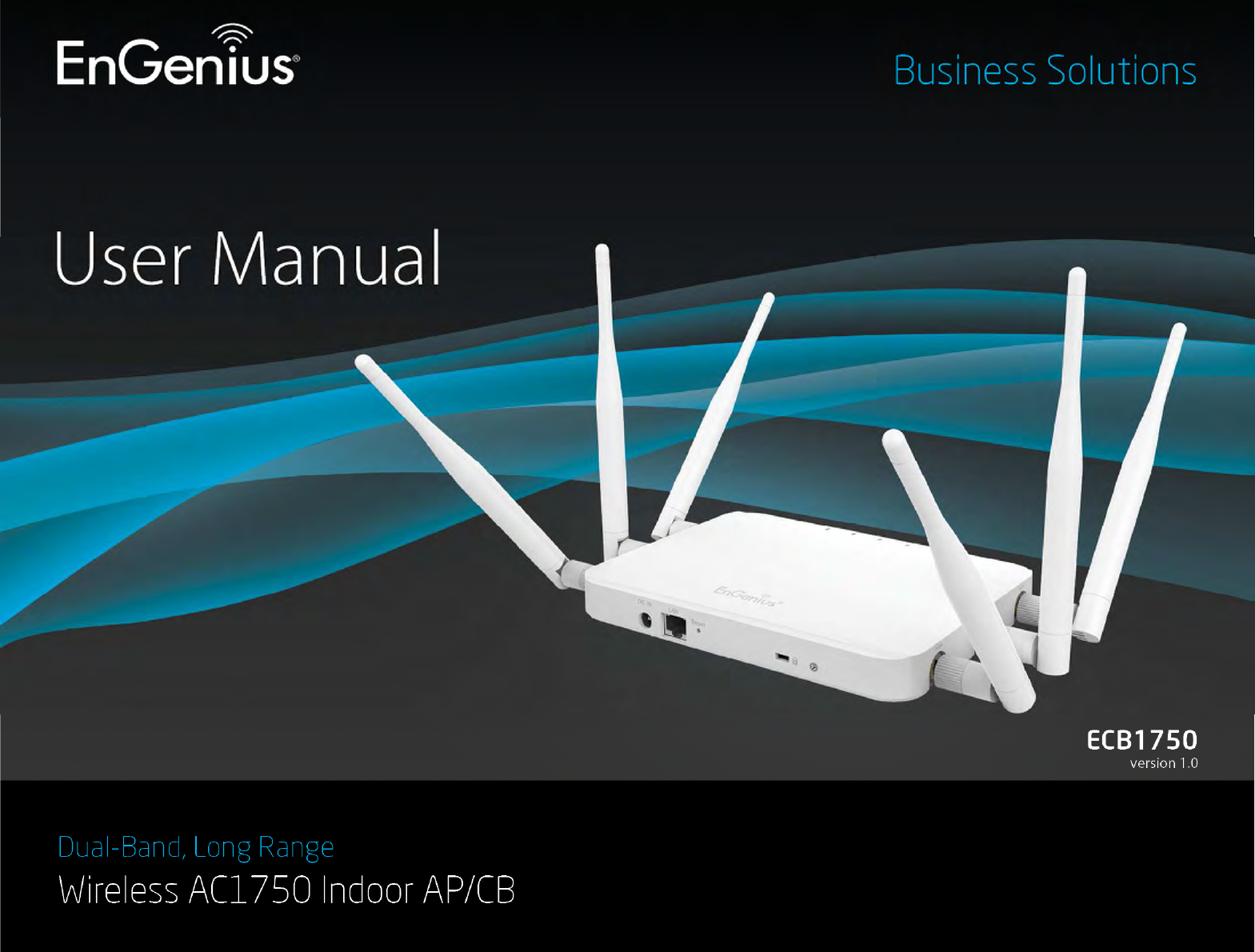
Table of Contents
1

Table of Contents
1
1 Introduction ....................................................................................................................................................................... 5
1.1 Features and Benefits ..................................................................................................................................................................................... 6
1.2 Package Contents ............................................................................................................................................................................................ 7
1.3 System Requirements ..................................................................................................................................................................................... 8
1.4 Applications ....................................................................................................................................................................................................... 8
2 Before you Begin ............................................................................................................................................................. 10
2.1 Considerations for Wireless Installation ............................................................................................................................................... 10
2.2 Computer Settings (in Windows XP/Windows 7/Windows 8) ...................................................................................................... 11
2.3 Computer Settings in Apple Mac OS X ................................................................................................................................................. 15
2.4 Hardware Installation ................................................................................................................................................................................... 16
3 Configuring Your ECB1750 ............................................................................................................................................. 20
3.1 Default Settings ............................................................................................................................................................................................. 20
3.2 Web Configuration ....................................................................................................................................................................................... 21
4 Building a Wireless Network ......................................................................................................................................... 23
4.1 Access Point Mode ....................................................................................................................................................................................... 23
4.2 Client Bridge Mode ...................................................................................................................................................................................... 24
4.3 WDS AP / WDS Station Mode .................................................................................................................................................................. 25
4.4 WDS Bridge Mode ........................................................................................................................................................................................ 26
5 Overview........................................................................................................................................................................... 27
5.1 Device Status .................................................................................................................................................................................................. 27
5.2 Connections .................................................................................................................................................................................................... 28
5.3 Realtime ............................................................................................................................................................................................................ 29
6 Network ............................................................................................................................................................................ 32
2
6.1 Basic ................................................................................................................................................................................................................... 32
6.2 Spanning Tree Protocol .............................................................................................................................................................................. 33
6.3 Wireless ............................................................................................................................................................................................................ 34
7 Wireless Setting ............................................................................................................................................................... 36
7.1 Wireless Network .......................................................................................................................................................................................... 36
7.2 Wireless Security ........................................................................................................................................................................................... 39
7.3 Fast Roaming .................................................................................................................................................................................................. 48
7.4 Wireless MAC Filtering ................................................................................................................................................................................ 49
7.5 WDS Link Settings ......................................................................................................................................................................................... 50
8 Management .................................................................................................................................................................... 52
8.1 Administration ................................................................................................................................................................................................ 52
8.2 Management VLAN Settings .................................................................................................................................................................... 53
8.3 Wireless Traffic Shaping ............................................................................................................................................................................. 54
8.4 SNMP Settings ............................................................................................................................................................................................... 55
8.5 Backup/Restore .............................................................................................................................................................................................. 57
8.6 Firmware Upgrade ........................................................................................................................................................................................ 59
8.7 Time Settings .................................................................................................................................................................................................. 60
8.8 WiFi Scheduler ............................................................................................................................................................................................... 62
8.9 CLI Setting ....................................................................................................................................................................................................... 64
8.10 Systom Log ...................................................................................................................................................................................................... 65
8.11 Tools .................................................................................................................................................................................................................. 66
8.12 Device Discovery ........................................................................................................................................................................................... 68
8.13 LED Control ..................................................................................................................................................................................................... 69
8.14 Logout ............................................................................................................................................................................................................... 70
8.15 Reset .................................................................................................................................................................................................................. 71
Appendix A – FCC Interference Statement .......................................................................................................................... 72
3
Appendix B – IC Interference Statement .............................................................................................. 錯誤! 尚未定義書籤。
Appendix C – CE Interference Statement ............................................................................................................................. 73

4
Revision History
Version
Date
Notes
1.0
.0
201
4
10
24
First Release

Chapter 1 Introduction
5
1 Introduction
The
ECB1750
is a high-powered, long-range dual-band concurrent wireless 802.11ac/a/b/g/n access point with 5 major
functional modes. It is designed to operate in numerous environments from large homes, small and medium-sized
businesses, multiple-floor offices, hotels and other venues to larger enterprise deployments. Its high-powered, long-range
characteristics make it a cost-effective alternative to ordinary access points that don’t have the range and reach to connect
to a growing number of wireless users who wish to connect to a large home or business network.
The ECB1750 supports IEEE 802.11b/g/n standards in the 2.4GHz frequency band while at the same time supporting IEEE
802.11ac/a/n standards in the less congested 5GHz frequency band ideal for streaming or transferring other large files.
The ECB1750 delivers up to 6x faster wireless speeds and 7x extended coverage than legacy 802.11a/b/g wireless devices.
Even though the ECB1750 has been designed and engineered for traffic heavy and demanding business environments it is
also quite at home in larger house scenarios because it efficiently extends the wireless range of an existing home router,
especially in very architecturally-challenging structures to provide whole home connectivity.
To protect sensitive data during wireless transmissions, the ECB1750 offers different encryption settings for wireless
transmissions including industry-standard WPA and WPA2 encryption. The ECB1750 also includes MAC address filtering to
allow network administrators to offer network access only to known computers and other devices based on their MAC
addresses.

6
1.1 Features and Benefits
Features Benefits
3x3 MIMO High Speed Data Rate Up to 1,300
Mbps for 5GHz and 450Mbps for 2.4GHz
Capable of handling heavy data payloads such as HD multimedia
streaming.
High Transmit Power 24dBm for each 5Ghz
and 2.4GHz
Extensive long range connectivity
10/100/1000 Gigabit Ethernet Supports up to 1000Mbps wired networking speed.
IEEE 802.11ac Compliant and Backwards
Compatible with 802.11 n/a/b/g devices
Fully compatible with IEEE 802.11 ac/a/b/g/n devices.
Multiple Operation Modes Allowing users to select any one of the following modes: Access
Point, Client Bridge, WDS AP, WDS Bridge, WDS Station on their
specific networking deployment need.
Support Multiple SSIDs in AP mode (up to 8
in each frequency band)
Allows clients to access different networks through a single access
point and assign different policies and functions for each SSID
through the built-in software.
WPA/WPA2/IEEE 802.1x Support Supports industry-standard wireless encryption.
MAC Address Filtering in AP Mode For more secure network connections with known users and devices.
User Isolation Support (AP mode) Offers an additional layer of protection within the network by
isolating specific client users.
Power-over-Ethernet (IEEE802.3at) Allows installers to deploy the ECB1750 in locations via a PoE
connection (Ethernet cable) where a power outlet may not be
available.
Save User Settings Enables network administrators to save their device settings so
firmware upgrades do not permanently delete previous device
settings.

7
SNMP Remote Configuration Management Allows remote connection to configure or manage the ECB1750
easily.
QoS (WMM) support 802.11e Prioritizes bandwidth-intensive and sensitive data traffic.
IPv6 Address support ECB1750 supports Ipv6, you can use Ipv6 address in ECB1750.
Band Steering When Band Steering is activated dual-band client devices are
associated to the ECB1750 access point on the 5 GHz frequency band.
Traffic Shaping Download and Upload Bandwidth Control Per SSID
Engenius EZ Controller Management
(Optional)
Software-based EZ Controller Can Central Configure, Monitor APs.
1.2 Package Contents
The ECB1750 package contains the following items (Resellers and dealers require that all items must be in package to issue
a refund):
ECB1750 Access Point/Client Bridge/WDS
12V/2A 100V~240V Power Adapter
RJ-45 Ethernet LAN Cable
2.4 GHz Detachable Antenna x 3
5 GHZ Detachable Antenna x 3
Wall Mount Screw Kit
CD with User's Manual
Quick Installation Guide
8
1.3 System Requirements
The following are the Minimum System Requirements in order configure the device.
Computer with an Ethernet interface or wireless network capability
Windows OS (XP, Vista, 7, 8), Mac OS X, or Linux-based operating systems
Web-Browsing Application (i.e.: Internet Explorer, Firefox, Safari, or other similar browser application)
1.4 Applications
Wireless LAN (WLAN) products are easy to install and highly efficient. The following list describes the benefits of
deploying a wireless access point:
a) Difficult-to-Wire Environments
There are many situations where wires cannot be installed, deployed easily or cannot be hidden from view. Many
older buildings sites, or areas within a building may make the installation of an Ethernet-based LAN impossible,
impractical or expensive.
b) Temporary Workgroups
A deployed wireless access point or several access points, gives businesses the flexibility to create temporary
workgroups/networks in more open areas within a building – auditoriums, amphitheater classrooms, ballrooms,
arenas, exhibition centers, and temporary offices.
c) The Ability to Access Real-Time Information
Doctors/Nurses, Point-of-Sale Employees, and/or Warehouse Workers can access real-time information on their
network via the access point while dealing with patients, serving customers, and/or processing information.
9
d) Frequently Changing Environments
Setting up an access point, like the ECB1750, to provide access to a company network or its Internet connection is
quick and easy which also makes it ideal for establishing network access in temporary venues like exhibits, special
events, or show rooms.
e) Small Office and Home Office (SOHO) Networks
A wireless access point, like the EC1750, is ideal for SOHO users who need a cost-effective way to expand their
existing network to provide more access for more devices, easy and quick installation of a small network.
f) Wireless Extensions to Existing Ethernet-based Networks
Wireless access points, like the ECB1750, enable network administrators, installers and end-users to extend the range
and reach of an existing Ethernet-based network.
g) Training/Educational Facilities
Training sites at corporations and universities deploy wireless access points to provide connectivity their networks
and the Internet connection for their employees and students.

Chapter 2 Before You Begin
10
2 Before you Begin
This section will guide you through the installation process. Placement of the EnGenius ECB1750 is essential to maximize
the access point’s performance. Avoid placing the ECB1750 in an enclosed space such as a closet, cabinet, or stairwell.
2.1 Considerations for Wireless Installation
Generally, the exact operating distance of a wireless device, like the ECB1750, cannot be pre-determined due to a number
of unknown variables or obstacles in the environment in which the device will be deployed. These could be the number,
thickness, and location of walls, ceilings, elevator shafts, stairwells, or other objects that the device's wireless signals must
pass through. Here are some key guidelines to allow the ECB1750 to have optimal wireless range.
Keep the number of walls and/or ceilings between the ECB1750 and other network devices to a minimum. Each wall
and/or ceiling can reduce the signal strength, resulting in lower signal strength.
Building materials make a difference. A solid metal door and/or aluminum studs may have a significant negative
effect on the signal strength of the ECB1750. Locate your wireless devices carefully so the signal can pass through
drywall and/or open doorways. Materials such as glass, steel, metal, concrete, water (example: fish tanks), mirrors, file
cabinets and/or brick can also diminish wireless signal strength.
Interference from other electrical devices and/or appliances that generate RF noise can also diminish the ECB1750’s
signal strength. The most common types of devices are microwaves or cordless phones.
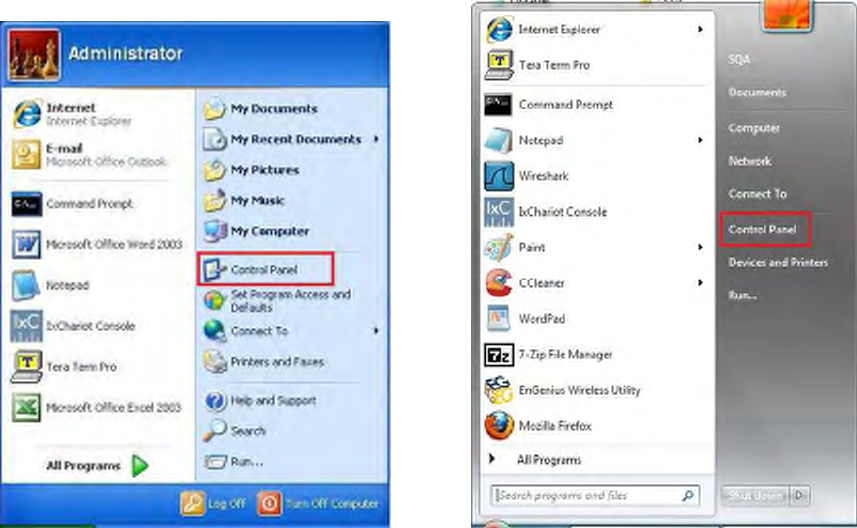
11
2.2 Computer Settings (in Windows XP/Windows 7/Windows 8)
In order to use the ECB1750, you must first configure the TCP/IPv4 connection of your Windows OS computer system.
Click Start button and open Control Panel.
Windows XP Windows 7
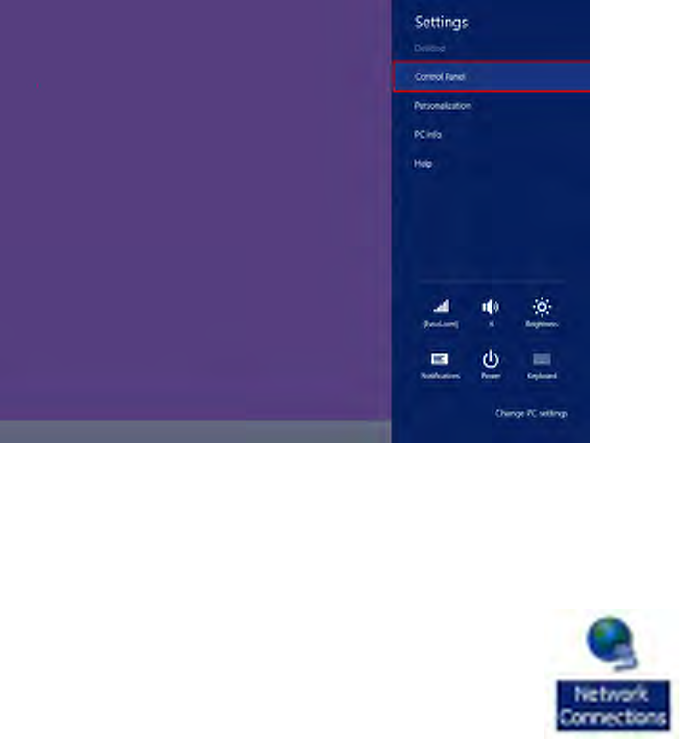
12
Move your mouse to the lower right hot corner to display the Charms Bar and select the Control Panel in Windows 8
Windows 8
In Windows XP, click Network Connections
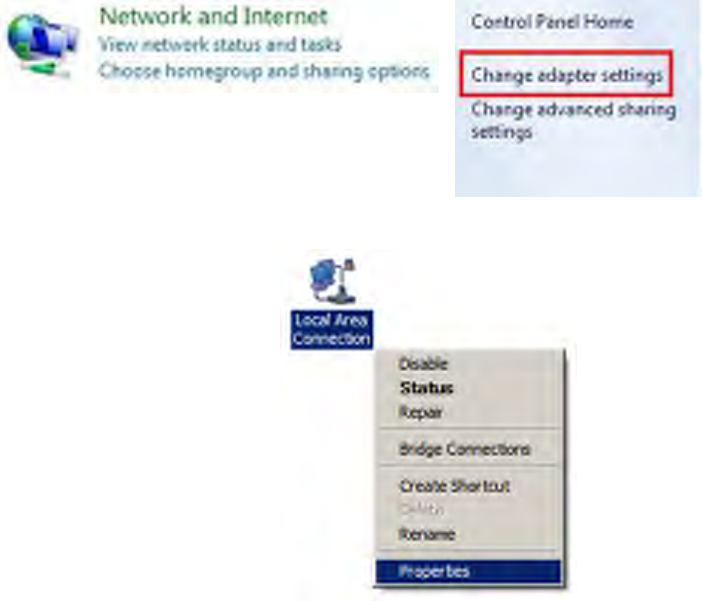
13
In Windows 7/Windows 8, click View Network Status and Tasks in the Network and Internet section, then select
Change adapter settings
Right click on Local Area Connection and select Properties
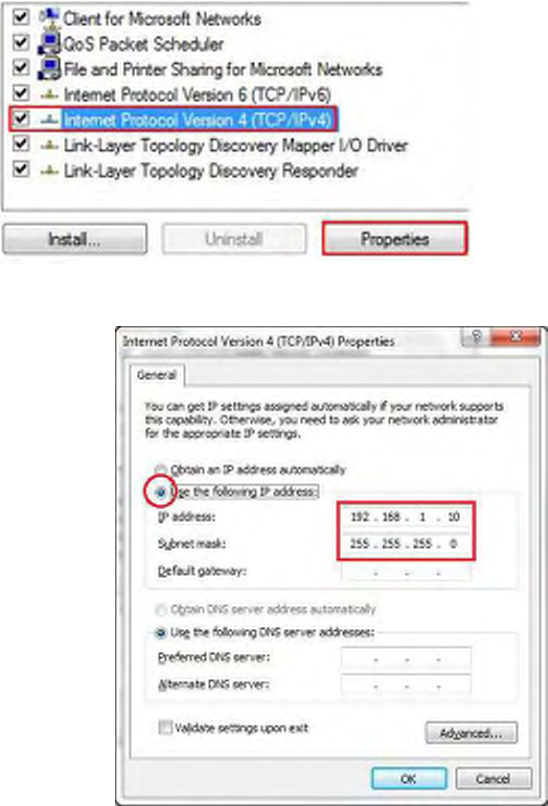
14
Select “Internet Protocol Version 4 (TCP/IPv4)” and then
select Properties
Select Use the following IP address and enter an IP address that is
different from the ECB1750 and subnet mask then click OK.
Note: Ensure that the IP address and subnet mask are on the same subnet as
the device.
For example: ECB1750 IP address: 192.168.1.1
PC IP address: 192.168.1.2 – 192.168.1.255
PC subnet mask: 255.255.255.0
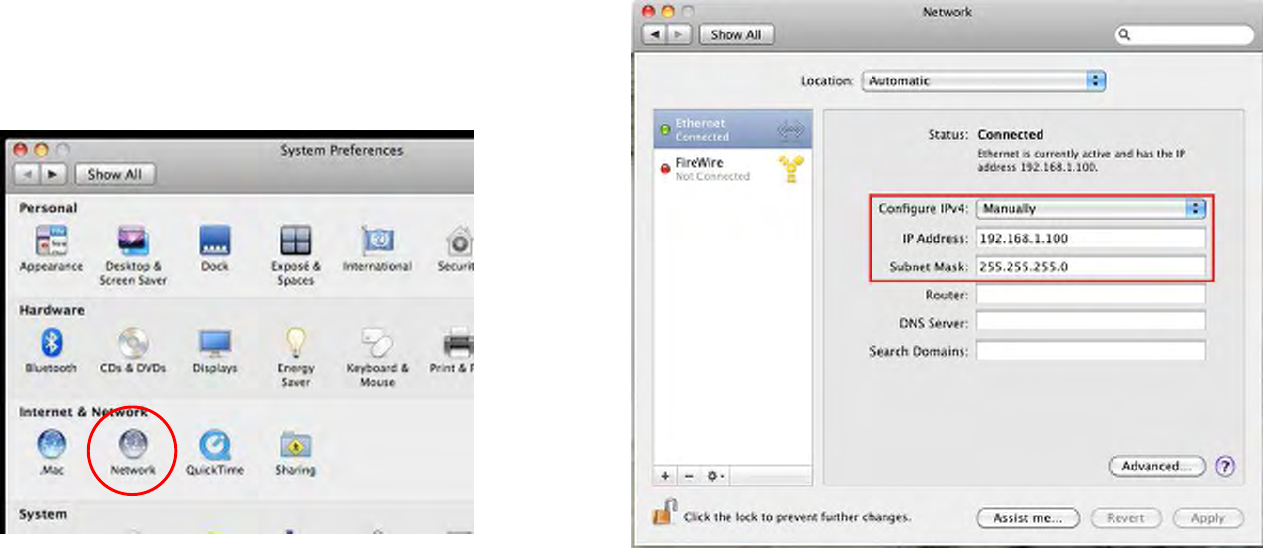
15
2.3 Computer Settings in Apple Mac OS X
Go to System Preferences (can be opened in the Applications folder or selecting it in the Apple Menu)
Select Network in the Internet & Network section
Highlight Ethernet
In Configure IPv4, select Manually
Enter an IP address that is different from the ECB1750 and subnet mask then press OK
Note: Ensure that the IP address and subnet mask are on the same subnet as the device.
For example: ECB1750 IP address: 192.168.1.1
PC IP address: 192.168.1.2 – 192.168.1.255
PC subnet mask: 255.255.255.0
Click Apply when done.
16
2.4 Hardware Installation
1. Ensure that the computer in use has an available Ethernet (RJ-45) Port. For more information, verify with your
computer’s user manual.
2. Connect one end of the Category 5e Ethernet cable into the RJ-45 port of the ECB1750 and the other end to the RJ-45
port of the computer. Ensure that the cable is securely connected to both the ECB1750 and the computer.
3. Connect the Power Adapter DC connector to the DC-IN port of the ECB1750 and the Power Adapter to an available
electrical outlet. Once both connections are secure, verify the following:
a) Ensure that the POWER light is on (it will be orange).
b) Ensure that the 2.4GHz/5GHz WLAN light is on (both will be blue.).
c) Ensure that the LAN (Computer/ECB1750 Connection) light is on (it will be blue).
d) Once all lights are on, proceed to set up the ECB1750 using the computer.
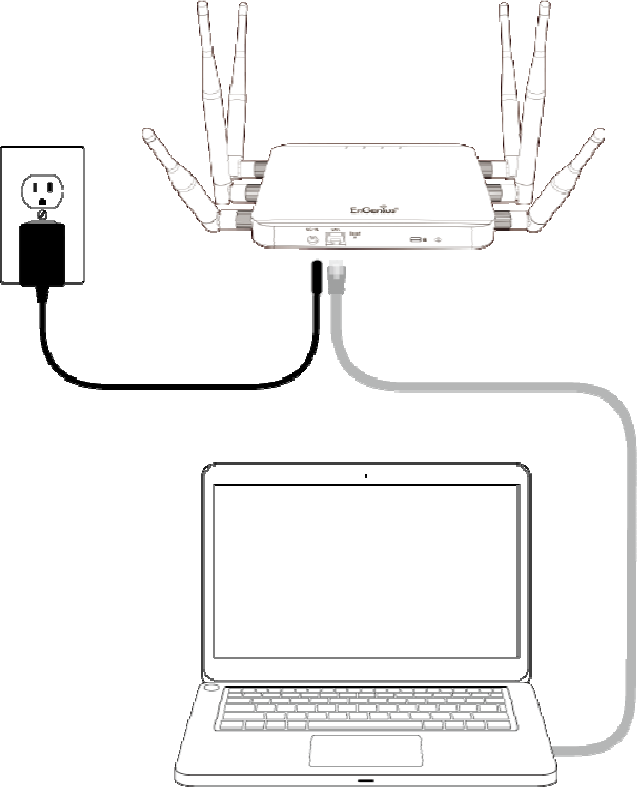
17
This diagram depicts the hardware configuration.
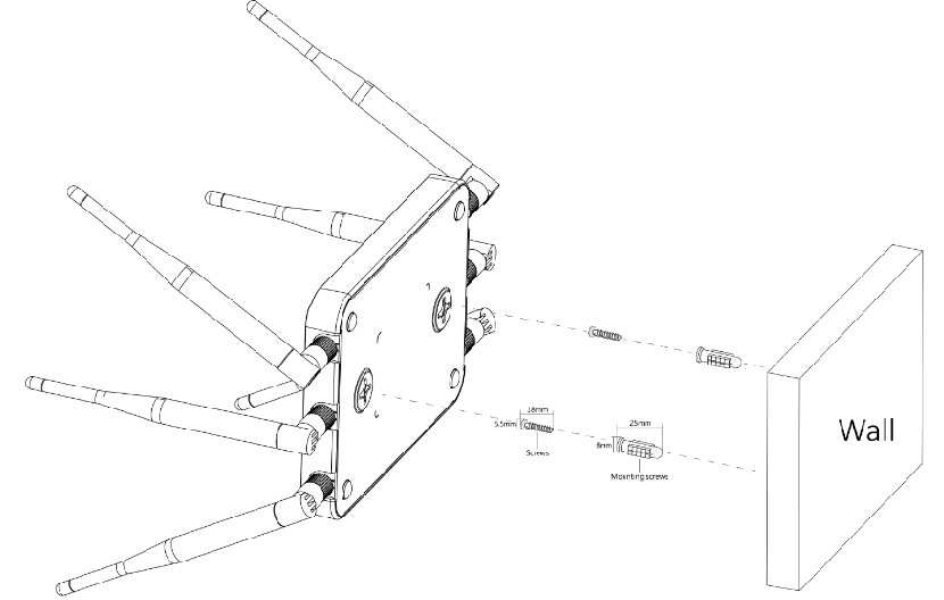
18
Mounting the ECB1750
To attach ECB1750 on a wall using included mounting screw kit.
1. Drill the holes to input the mounting screws.(25mm x 8mm)
2. Use the included screws (18mm x 5.5mm) to attach on ECB1750
3. Lock ECB1750 on the mounting screws.
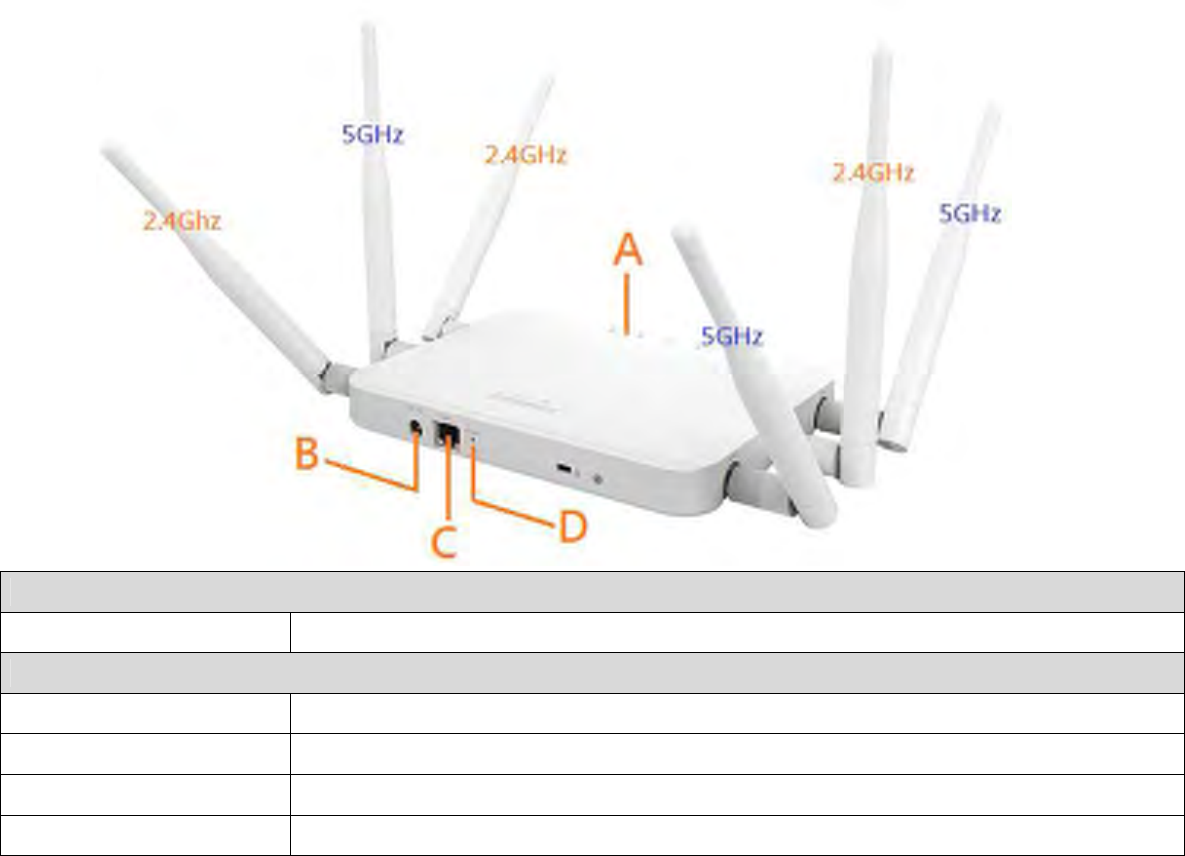
19
Front Panel
A.
LED Lights
LED lights for Pow
er
,
Gigabit
Ethernet port, WLAN 2.4G
Hz
and WLAN 5G
Hz
Rear
Panel
B.
Power
12V
DC IN for Power.
C.
Gigabit
Ethernet Port
802.3at PoE
Gigabit
Ethernet port for RJ
-
45 cable.
D.
Reset Button
One click for reset the device. Press over 10 seconds for reset to factory
default.
Kingston Security Slot
To protect your ECB1750, attach on a cable lock.

Chapter 3 Configuring Your ECB1750
20
3 Configuring Your ECB1750
This section will show you how to configure the device using the web-based configuration interface.
3.1 Default Settings
Please use your Ethernet port or wireless network adapter to connect the ECB1750.
Default Settings
IP Address
192.168.
1
.1
Username / Password
admin / admin
Operation
Mode
AP / AP

21
3.2 Web Configuration
Open a web browser (Internet Explorer/Firefox/Safari) and enter the IP Address http://192.168.1.1
Note: If you have changed the default LAN IP Address of the Access Point, ensure you enter the correct IP Address.
The default username and password are admin. Once you have entered the correct username and password, click the
Login button to open the web-base configuration page.
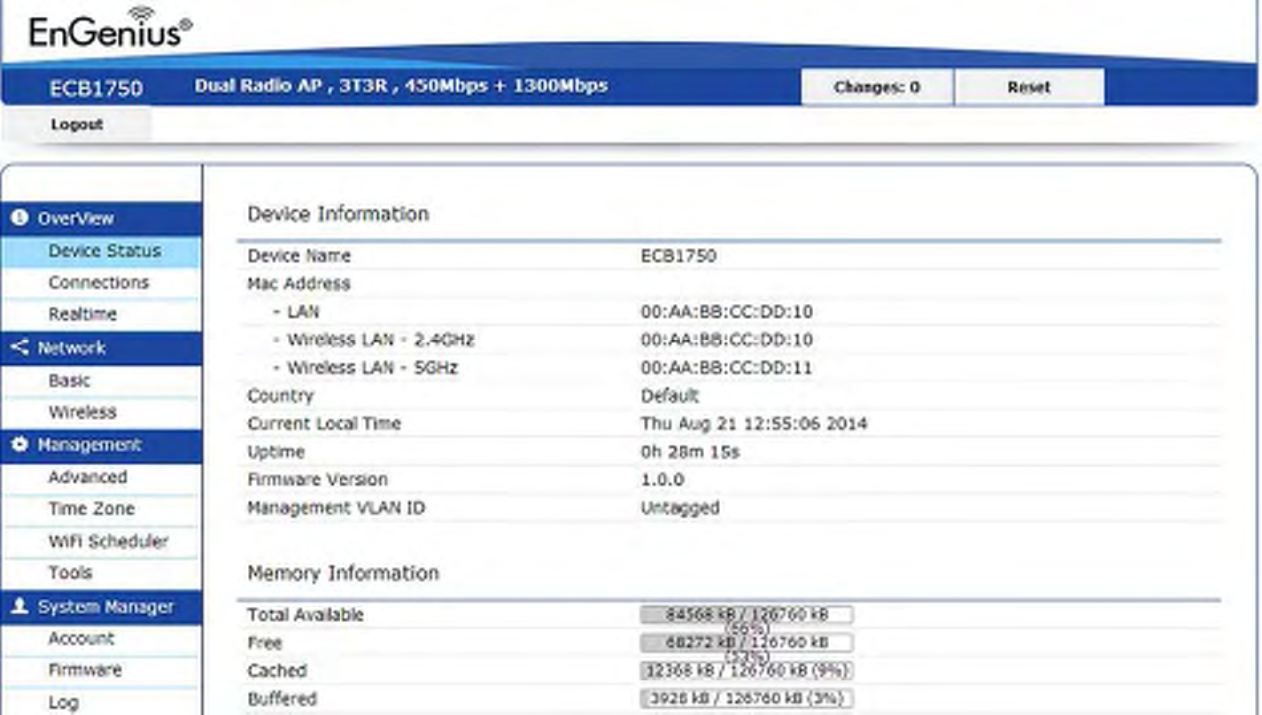
22
If successful, you will be logging in and see the ECB1750 User Menu.
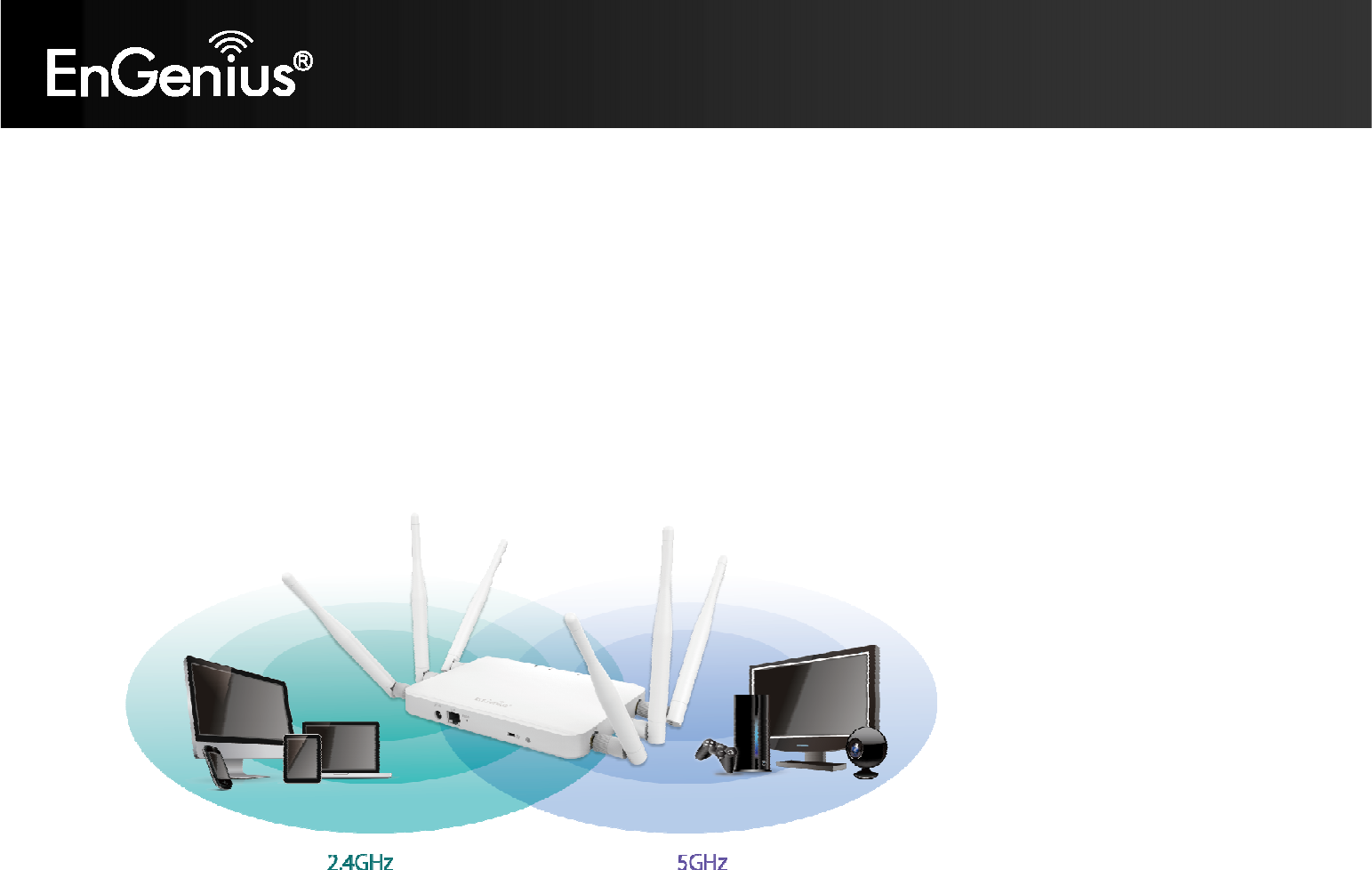
Chapter 4 Building a Wireless Network
23
4 Building a Wireless Network
The ECB1750 has the ability to operate in various modes. This chapter describes the operating modes of the ECB1750.
4.1 Access Point Mode
In Access Point Mode, ECB1750 behaves likes a central connection for stations or clients that support
IEEE 802.11ac/a/b/g/n networks. The stations and clients must be configured to use the same SSID (Service Set Identifier)
and security password to associate with the ECB1750. The ECB1750 supports up to eight SSIDs at the same time for secure
access.
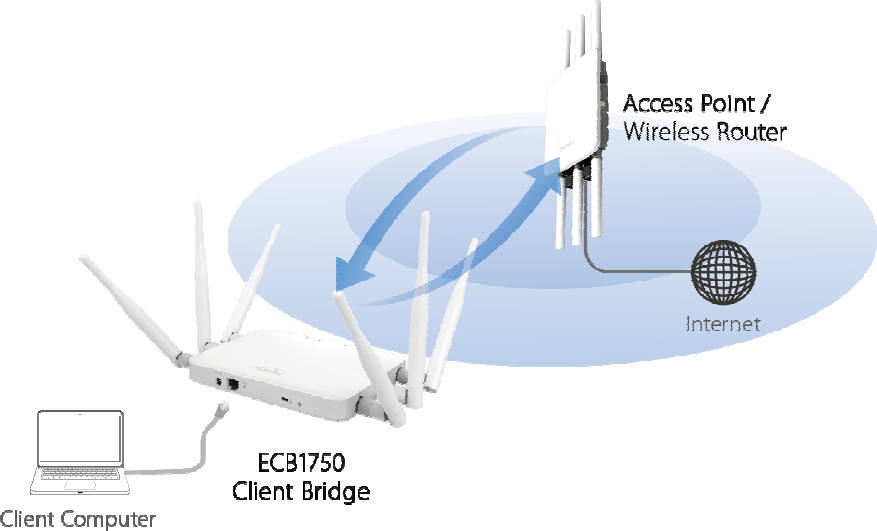
24
4.2 Client Bridge Mode
In Client Bridge Mode, the ECB1750 essentially acts as a wireless adapter that connects to an access point to allow a
system wireless access to the network. This mode requires you to connect the Ethernet port on your PC to the ECB1750
LAN port.
If you use the client bridge operating mode, use the ECB1750 AP Detection feature to scan for Access Points within range.
When you find an Access Point, configure the ECB1750 to use the same SSID and Security Password as the Access Point to
associate with it.
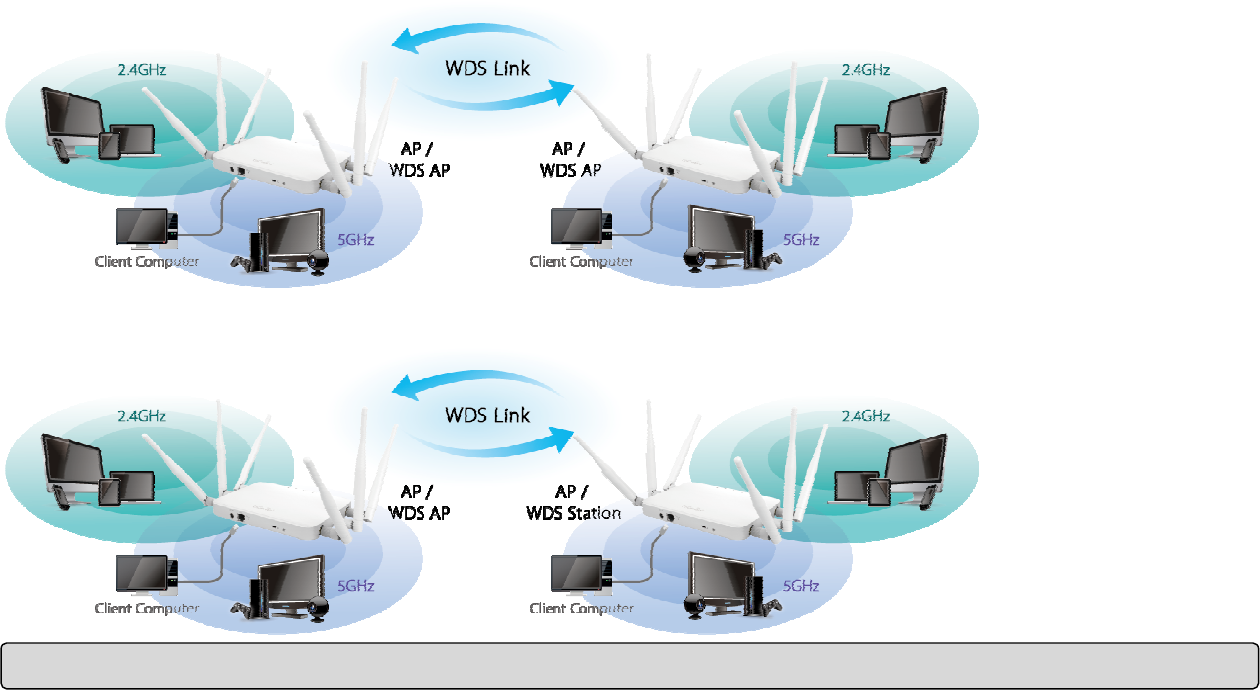
25
4.3 WDS AP / WDS Station Mode
The ECB1750 also supports WDS AP mode. This operating mode allows wireless connections to the ECB1750 using WDS
technology. In this mode, configure the MAC addresses in both Access Points to enlarge the wireless area by enabling
WDS Link settings. WDS supports four AP MAC addresses.
Note
:
WDS
Station
Mode does not
support
Access Point
fea
ture
.
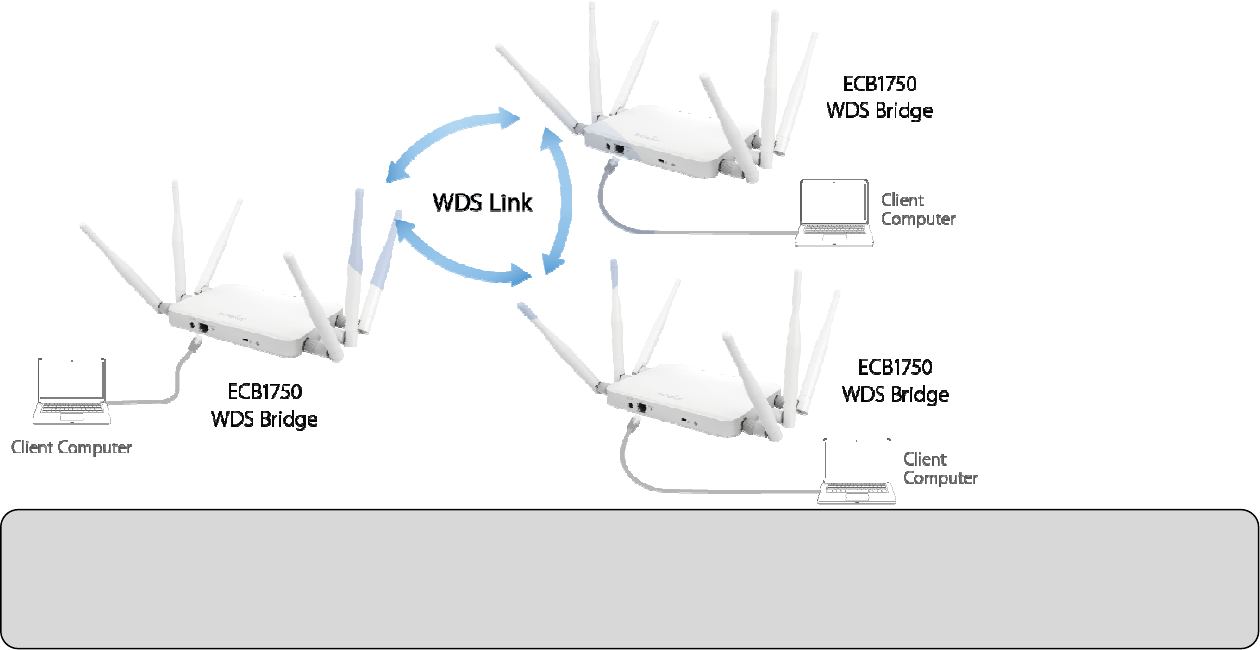
26
4.4 WDS Bridge Mode
In WDS Bridge Mode, the ECB1750 can wirelessly connect different LANs by configuring the MAC address and security
settings of each ECB1750 device. Use this mode when two wired LANs located a small distance apart want to
communicate with each other. The best solution is to use the ECB1750 to wirelessly connect two wired LANs, as shown in
the following figure. WDS Bridge Mode can establish four WDS links, creating a star-like network.
Note: WDS Bridge Mode does not act as an Access Point. Access Points linked by WDS are using the same frequency channel. More
Access Points connected together may lower throughput. This configuration can be susceptible to generate endless network loops in
your network, so it is recommended to enable the Spanning Tree setting (see 6.3 Spanning Tree Setting, below) to prevent this from
happening.
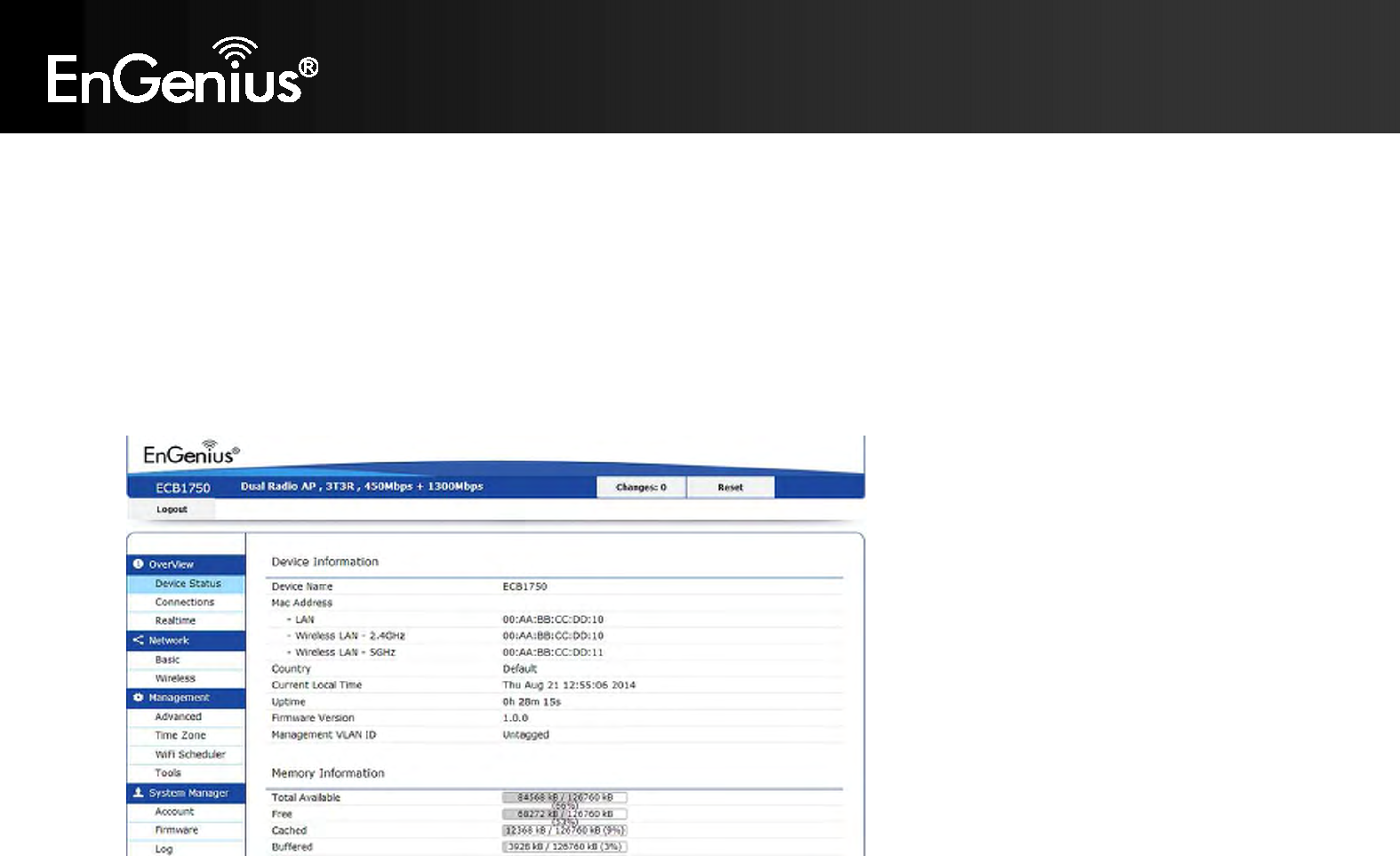
Chapter 5 Overview
27
5 Overview
The overview section contains the following options:
- Device Status
- Connections
- Realtime
5.1 Device Status
Click the Device Status link under the Overview menu shows the current status of information about operating mode.
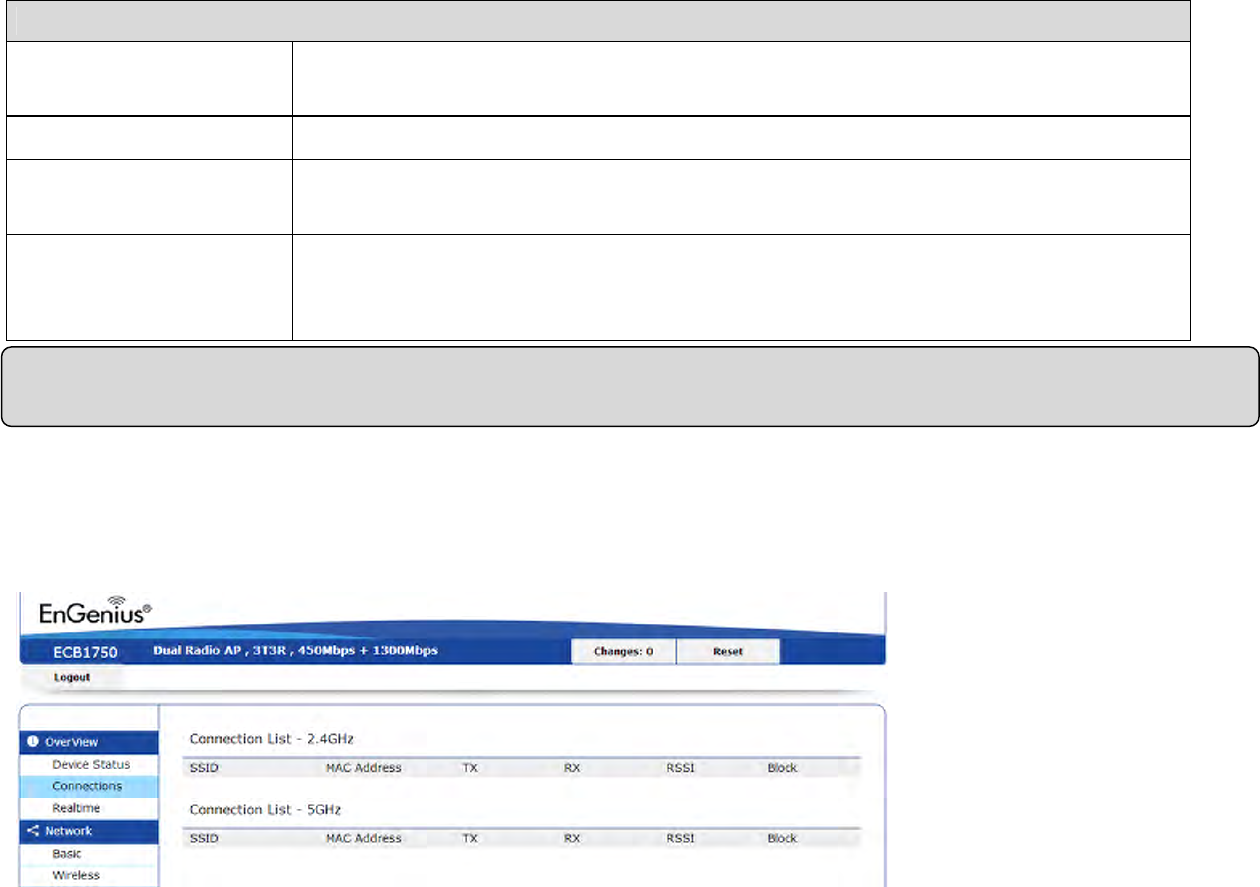
28
System Properties
Device
Information
General syst
em information such as device name, MAC address, current time,
firmware version and management VLAN ID.*
Memory Information
Total available memory, includes Free + Cached + Buffered.
LAN Information
the local area network settings such as the LAN IP addr
ess, Subnet Mask, Gateway,
DNS, DHCP client and Spanning Tree Protocol(STP) status.
Wireless LAN
Information
2.4GHz and 5GHz 2 bands operation mode setting, frequency, channel status. Since
ECB1750 support 8SSIDs per band, it displays each SSID security setting and VLAN
ID assignment.*
- Wireless LAN Information: it shows 2.4GHz and 5GHz 2 band operation mode setting, frequency,
5.2 Connections
ECB1750 automatically logs(record) event of possible interest in its internal memory. To view the logged information, click
Connection under Overview menu, if there is not enough memory to log all events, older events are deleted from the log.
When powered down or rebooted, the log will be cleared.
Note
1
: VLAN ID is only applicable in Access Point
mode
or WDS AP mode.
Note 2: Profile setting is only applicable in Access Point mode or WDS AP mode.
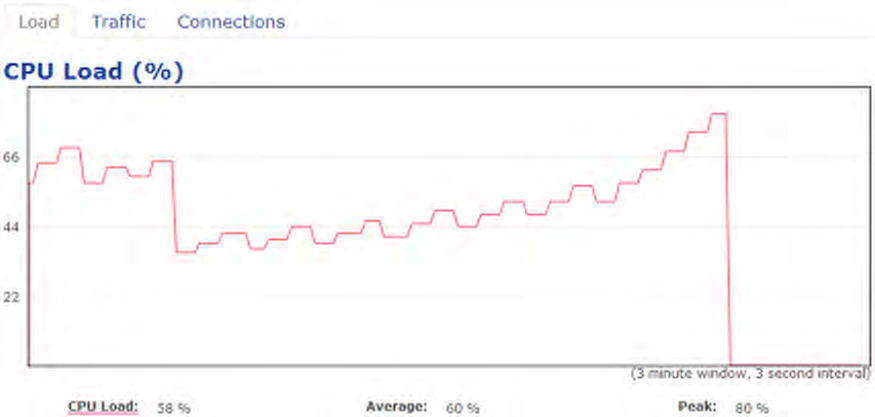
29
5.3 Realtime
The Realtime section contains the following options:
CPU Load:
3 minutes CPU loading percentage information, it displays current loading, average loading and peak loading status. Left
bar is loading percentage; button is time tracing. Interval is every 3 seconds.
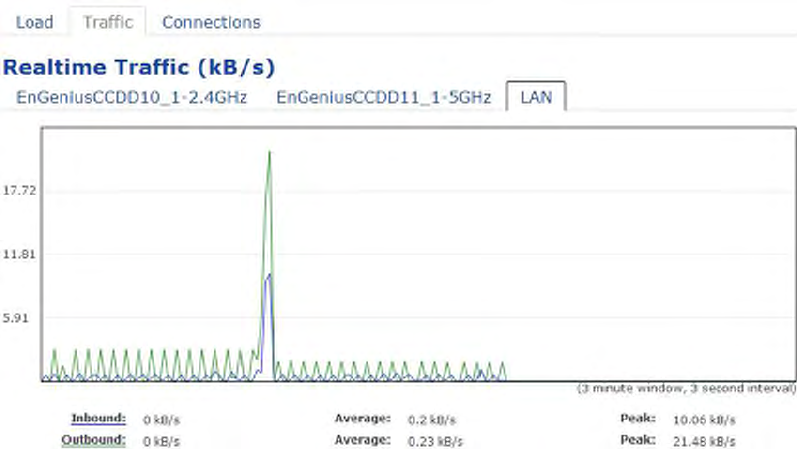
30
Realtime Traffic (kb/s):
2.4GHz and 5GHz and Ethernet port inbound and outbound traffic by current, average and peak time.
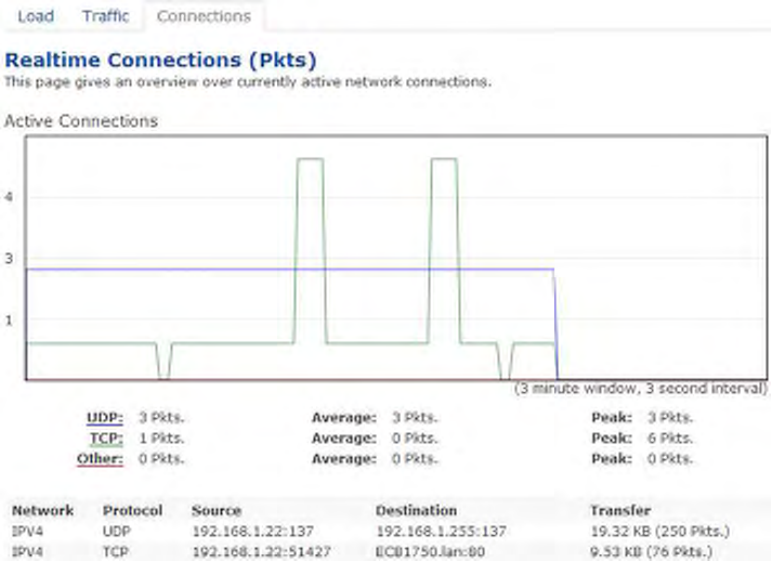
31
Realtime Connection (Pkts):
Overview on current active network connections. It displays UDP and TCP packets information and other connection status.
UDP connections curve is in blue; TCP connection curve is in green; others curve is in red. Below of chart shows
connections source and destination.
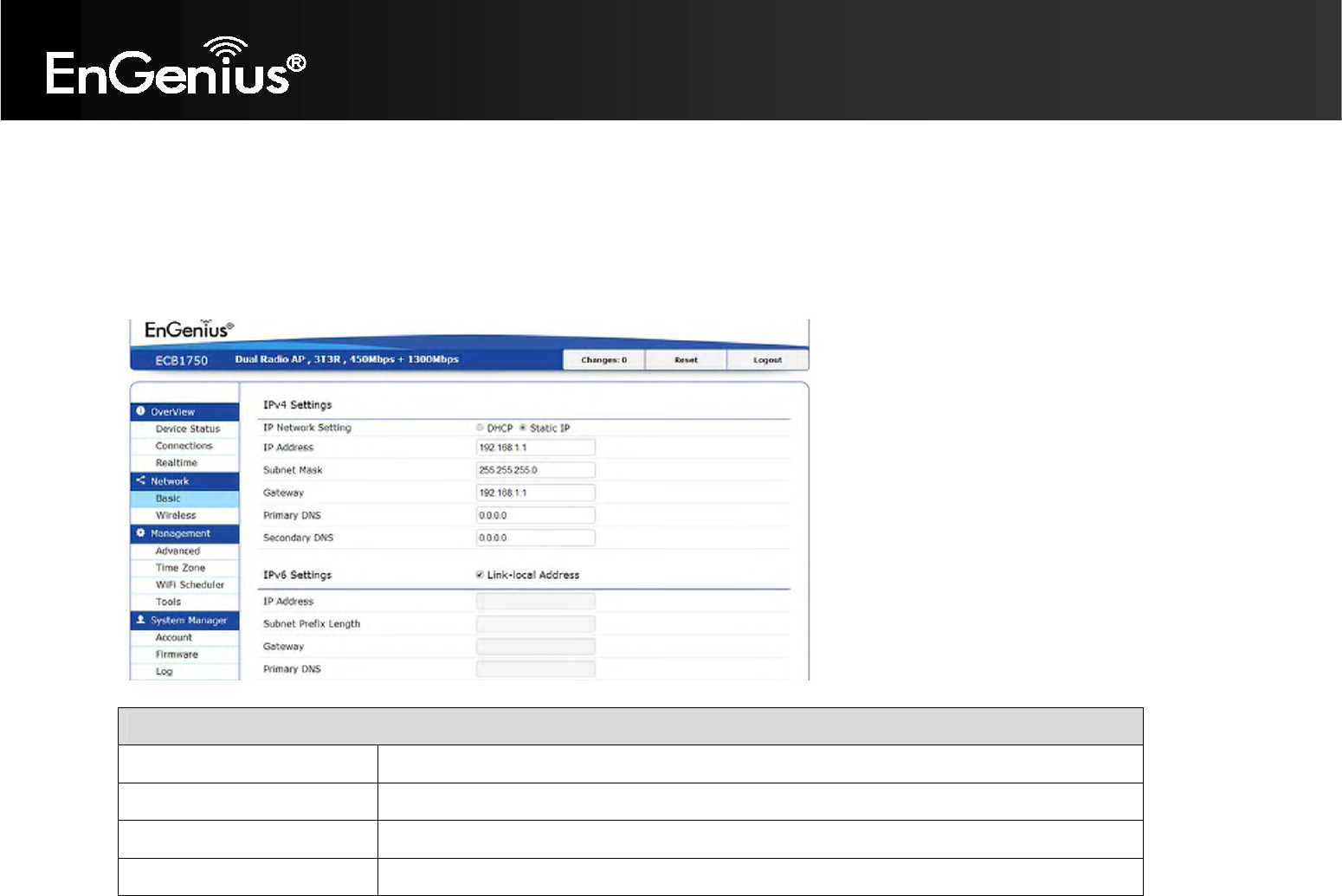
Chapter 6 Network
32
6 Network
6.1 Basic
This page allows you modify devices’ IP settings. ECB1750 supports IPv4 and IPv6.
System Pro
perties
IP Address
The IP address of this device.
IP Subnet Mask
The IP subnet mask of this device.
Gateway
The default gateway of this device
.
Leave it blank if you are unsure of setting.
Primary/Secondary DNS
The primary and secondary DNS address f
or this device.
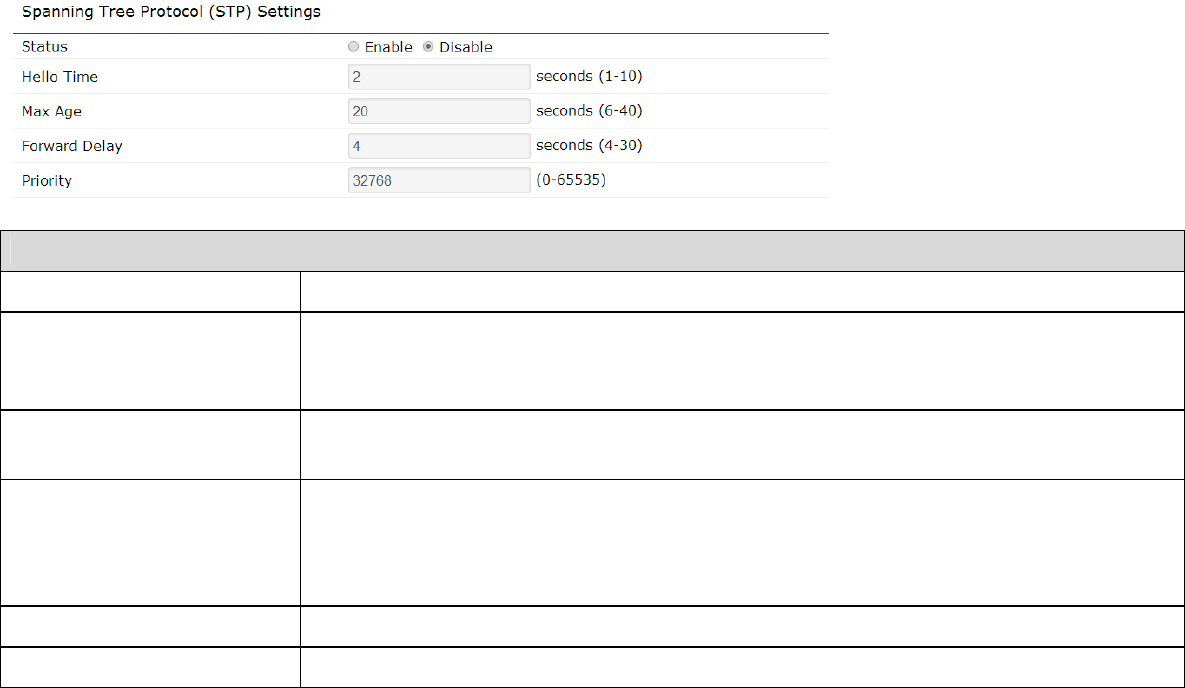
33
6.2 Spanning Tree Protocol
Spanning Tree Protocol setting under the Network sidebar, this function prevents network loops in your LAN network.
System Properties
Spanning Tree Status
E
n
able or disable the Spanning Tree function
Hello Time
S
p
ecify bridge Hello Time, in seconds. This value determines how often the device sends
handshake packets to communicate information about the topology throughput the entire
bridged local area network.
Max Age
Specify bridge Max Age, in seconds. If anoth
er bridge in the spanning tree does not send a
Hello packet for a long period of time, it is assumed to be in active.
Forward Delay
Specify bridge Forward Delay, in seconds. Forwarding Delay Time is the time spent in each
of the listening and learning status before the forwarding status is entered. This delay is
provided so that when a new bridge comes onto a busy network, it analyzes data traffic
before participating.
Priority
Specify the Priority number. A smaller number has greater priority.
Save
Clic
k Save to confirm changes.
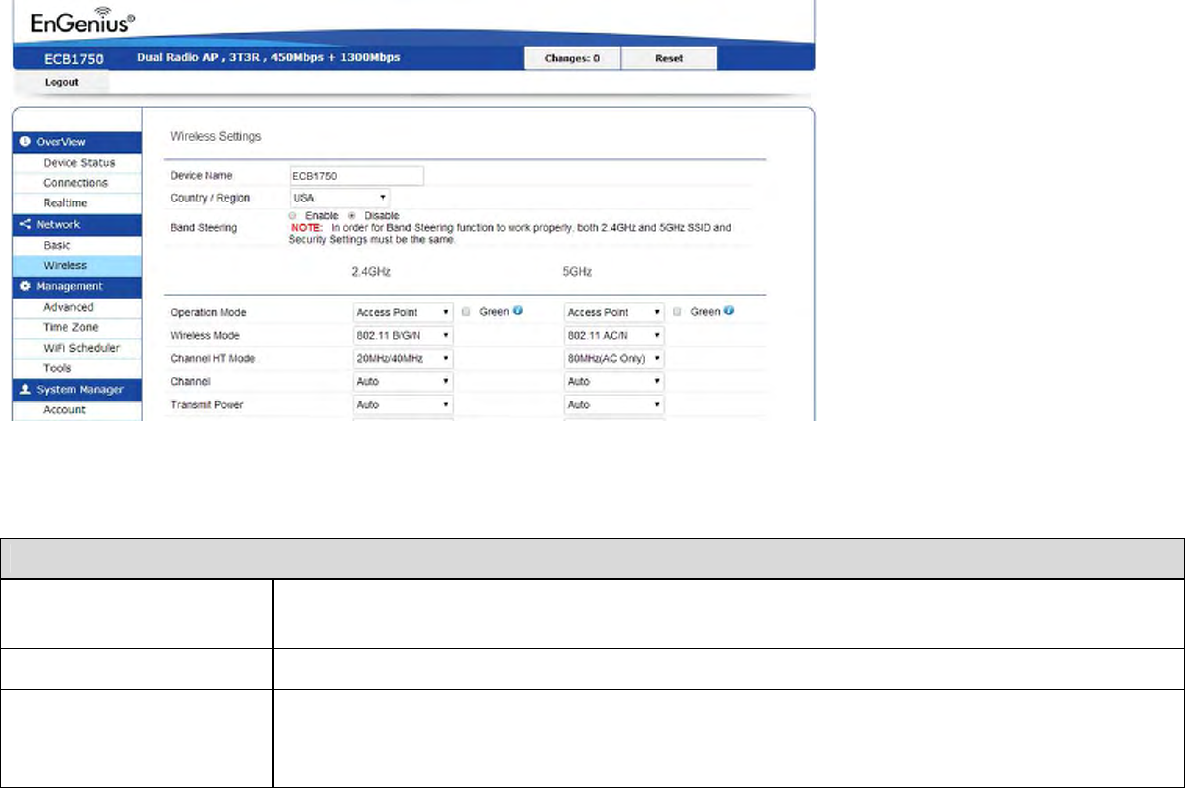
34
6.3 Wireless
The ECB1750 supports five operating modes: Access Point, Client Bridge, WDS AP, WDS Bridge, WDS Station.
To access operation mode, click Wireless section under Network in the sidebar. You will see Wireless setting customizable
options for both 2.4GHz and 5GHz. Under Wireless Setting you will see following items:
System Properties
Device Name
Enter a name for the device. The name you type appears in SNMP management. This name is
not the SSID and is not broadcast to other devices.
Region
Select
Region
to conform to local regulations.
Band Steering
Send 802.11n client to the 5GHz band, where 802.11b/g clients cannot g
o and leave
802.11b/g clients in 2.4GHz to operate their slower rate. Band Steering works within the
Access Point by directing 5GHz-capable clients to the band.*

35
Operation Mode
Use the radio button to select an operating mode.
Wireless Setting
s
2.4GHz
Edit SSID for VLAN ID assignment, encryption setting, MAC
al
low
,
deny list
and Traffic
Shapping per SS
ID bandwidth control.
Wireless Settings 5GHz
Edit SSID for VLAN ID assignment, encryption setting, MAC
allow
,
deny list
and Traffic
Shapping per SSID bandwidth control.
Guest Network Settings
Segregate temporary guest WiFi usage with individual SSID, se
curity and bandwidth control.
Save
Click
Save
to confirm the changes
.
Since ECB1750 is a dual band device, you can use operating modes which marked with ● concurrently.
2.4GHz
5GHz Access Point Client Bridge WDS AP WDS Bridge WDS Station
Access Point
●
●
●
●
●
Client Bridge
●
X
●
X
X
WDS AP
●
●
●
●
●
WDS Bridge
●
X
●
X
X
WDS Station
●
X
●
X
X
Note
:
When enable band steering function, both 2.4G
Hz and 5GHz SSID and security setting must be the same.
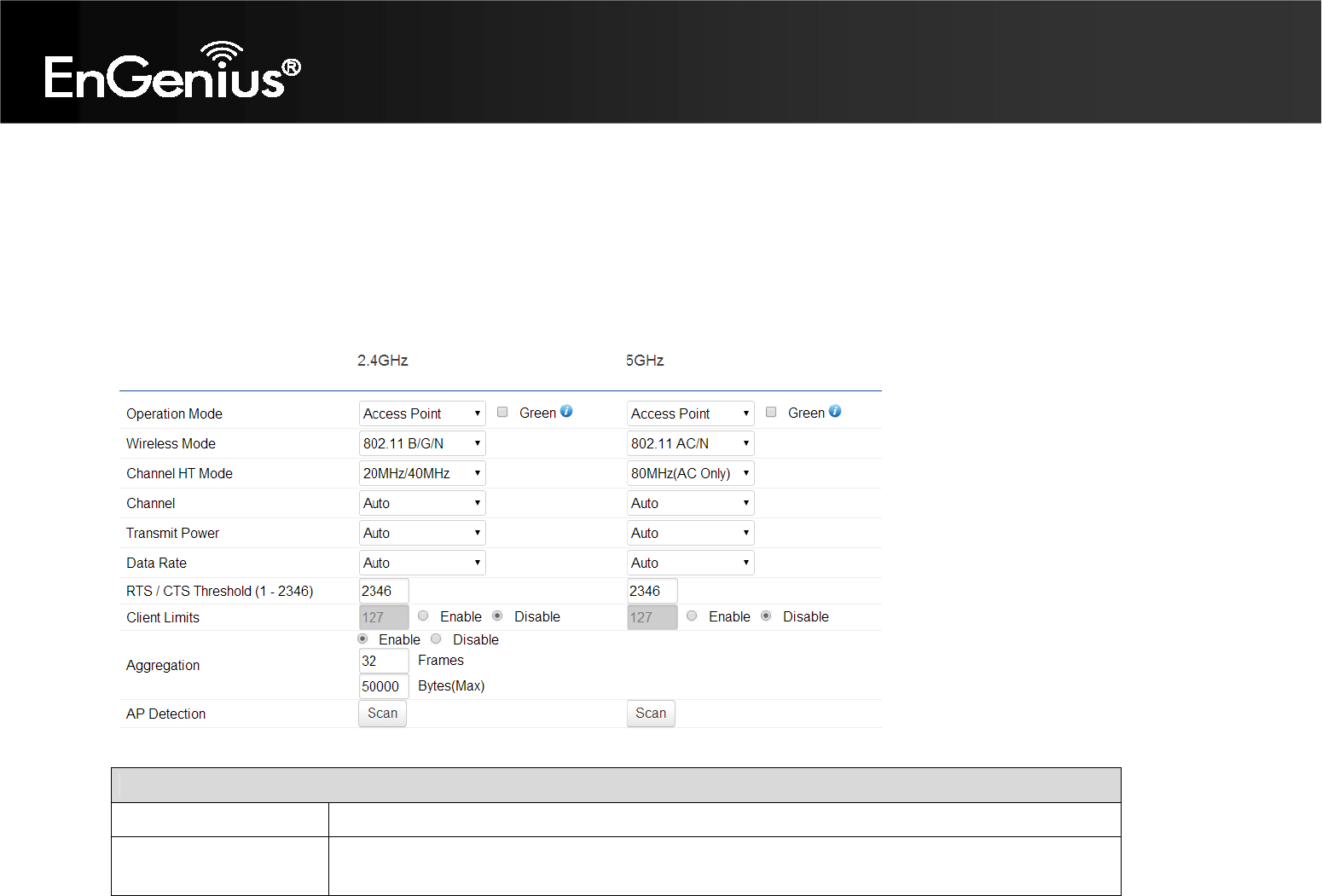
Chapter 7 Wireless Setting
36
7 Wireless Setting
7.1 Wireless Network
This page displays the current status of the Wireless settings of the ECB1750.
Access Point / WDS AP mode:
2.4G
/5G
Wireless Network
(Access Point
/
WDS AP
mode)
Wireless Mode
Wireless mode supports 802.11b/g
/n mixed mode
in 2.4G and 802.11
ac/
a/n mixed
mode
in 5G
.
Channel HT Mode
The default channel bandwidth is
20/
40MHz
and 80MHz(under 5GHz)
The larger the channe
l,
the better the transmission quality and speed.
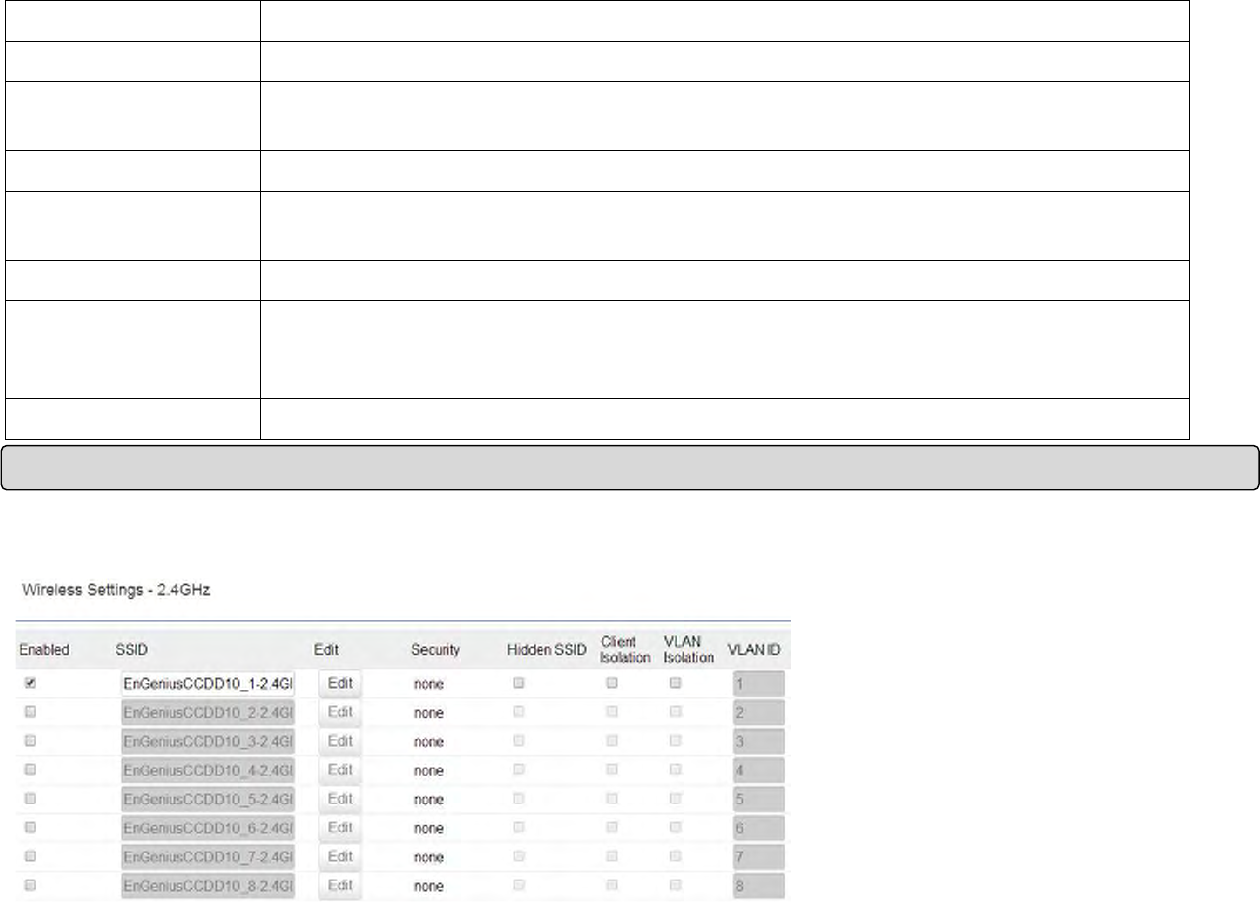
37
Channel / Frequency
Select the channel and frequency appropriate
.
Auto
Check this option to enable auto
-
channel selection.
RTS/CTS Threshold
Threshold packet size for RTC/CTS. A small number causes RTS/C
TS packet to be sent more
often and consumes more bandwidth.
Client Limit
Limit the total number of clients, maximum 127 clients per radio.
Aggregation
Merges data packets into one packet. This option reduces the number of packets, but also
increases packet size.
AP Detection
AP Detection can select the best channel to use by scanning nearby areas for Access Points.
Current Profile
Configure up to
eight
different SSIDs
(four in WDS AP mode).
If many client devices will be
accessing the network, you can arrange the devices into SSID groups. Click Edit to configure the
profile and check whether you want to enable extra SSID.
Save
Click
Save
to confirm the changes
.
2.4G/5G SSID Profile
Note:
Only
support four SSID in WDS AP mode.
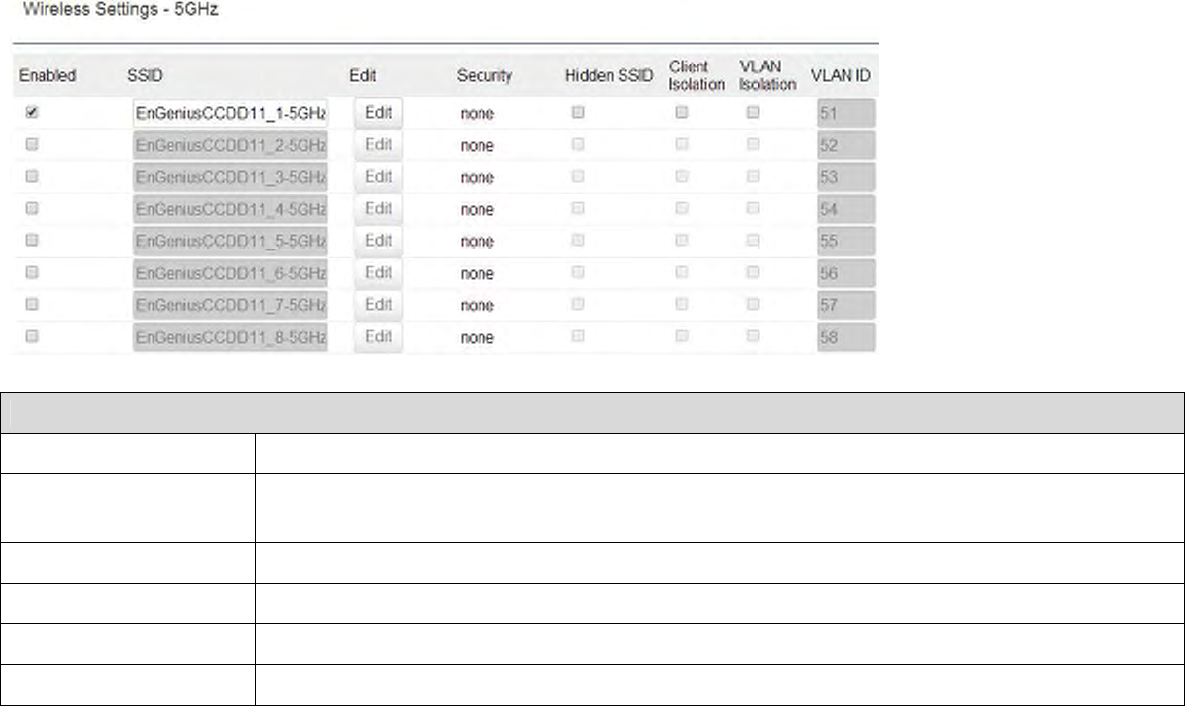
38
2.4G/5G
SSID Profile
SSID
Specify the SSID for the current p
rofile.
Suppressed SSID
Check this option to hide the SSID from clients. If checked, the SSID will not appear in the site
survey.
Station Separation
Click the appropriate radio button to allow or prevent communication between client devices.
Wireless Se
curity
See the Wireless Security section.
Isolation
Check the box to enable or disable Isolation function.
Save
Click Save to accept the changes
.
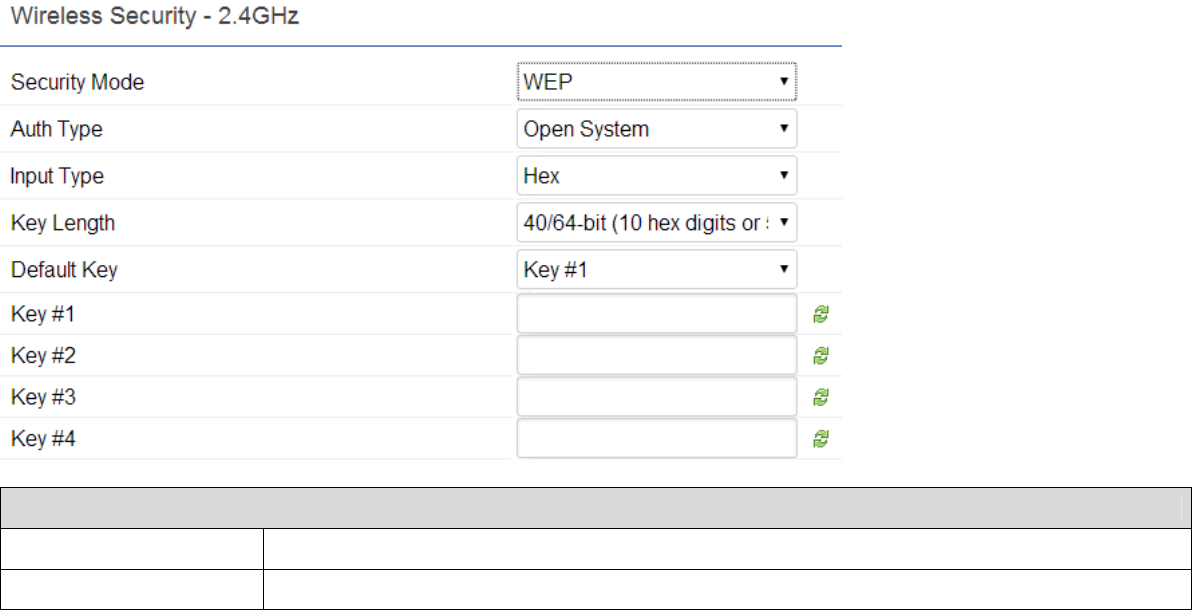
39
7.2 Wireless Security
The Wireless Security section lets you configure the ECB1750's security modes: WEP, WPA-PSK, WPA2-PSK, WPA-PSK
Mixed, WPA-Enterprise, WPA2-Enterprise, and WPA Mixed Enterprise. It is strongly recommend to use WPA2-PSK. Click Edit
button under Wireless Setting next to the SSID to change the Security setting.
WEP Encryption:
WEP Encryption
Auth
Type
Select
Open System
or
Shared
Key
.
Input
type
ASCII
: Regular T
ext (recommended)
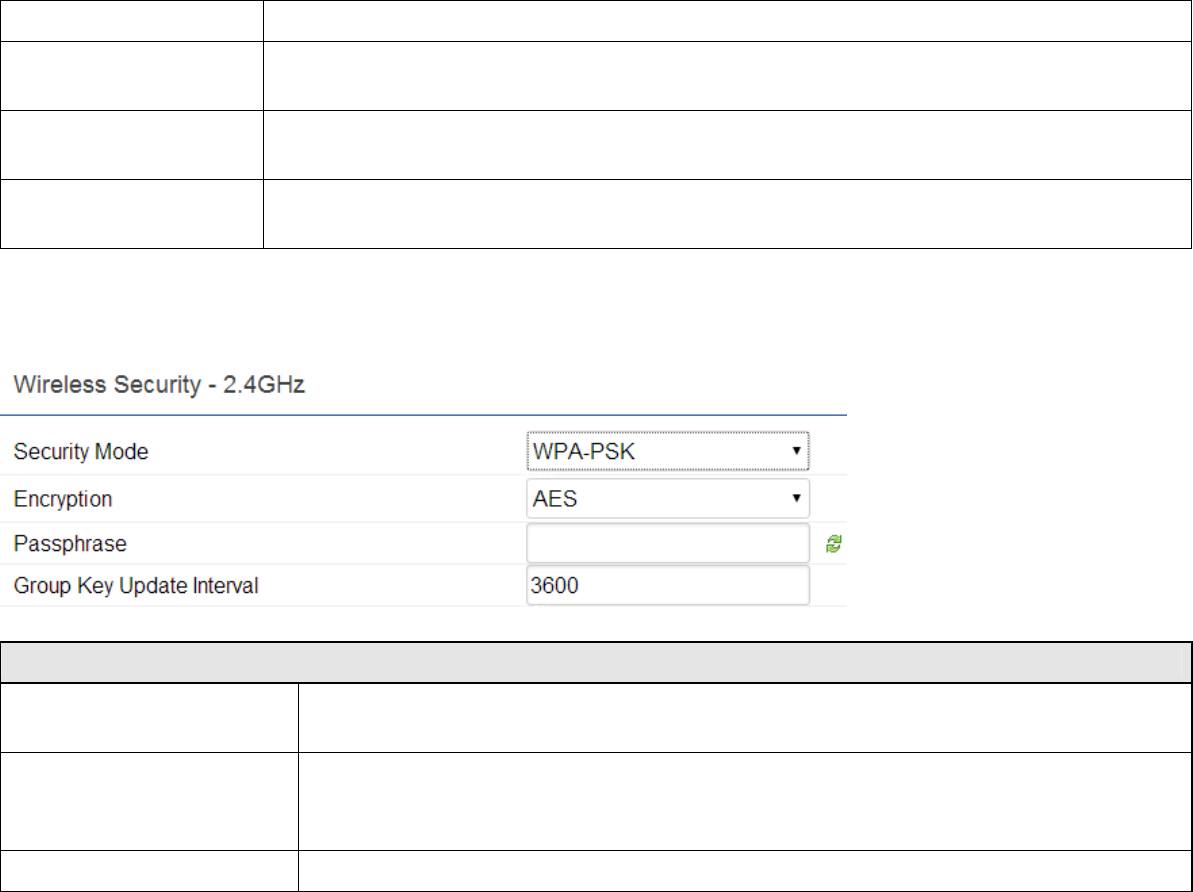
40
HEX:
Hexade
cimal Numbers (F
or advanced users
)
Key Length
Select the desired option
and ensure the wireless clients use the same set
ting.
Choices are 64, 128, 152-bit password lengths.
Default Key
Se
lect the key you wish to be
default. Transmitted data is ALWAYS encrypted using the Default
Key; the other Keys are for decryption only. You must enter a Key Value for the Default Key.
E
ncryption Key #
Enter the key value or values you wish to use. Only the Key selected as Default is required. The
others are optional.
WPA-PSK (WPA Pre-Shared Key) Encryption:
WPA
-
PSK (
WPA Pre
-
Shared Key
)
Encryption
Encryption
Select the WPA encrypt
ion
type
you would like.
Please ensure that your wireless clients use the same settings.
P
assphrase
Wireless clients must use the same key to associate the device.
If using ASCII format, the Key must be from 8 to 63 characters in length. If using HEX format,
the Key must be 64 HEX characters in length.
Group Key Update
I
nterval
Specify how often, in seconds, the group key changes.
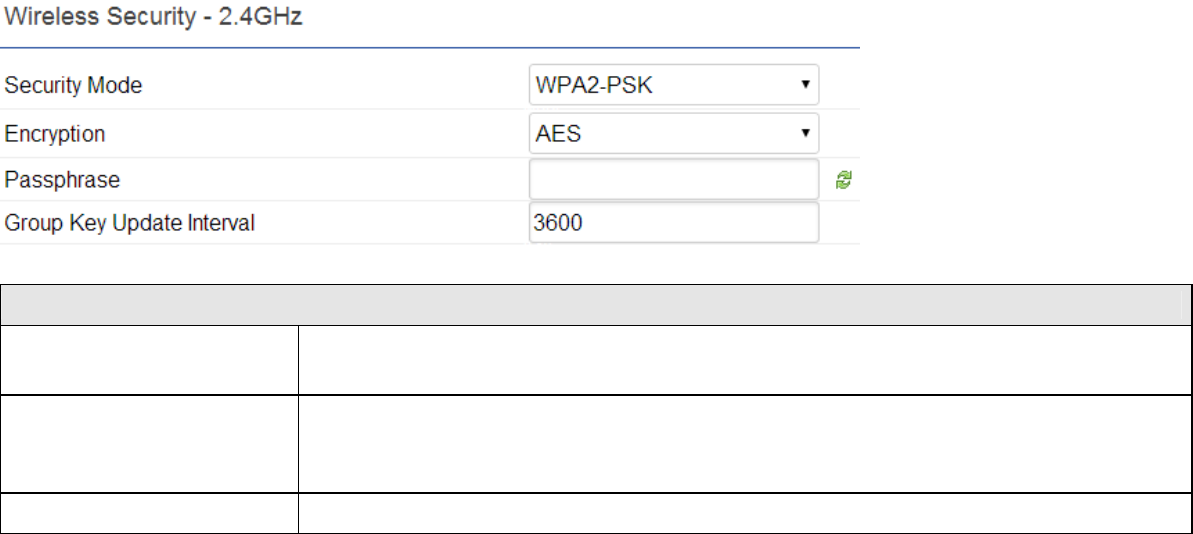
41
WPA2-PSK Encryption: Only in Access Point / WDS AP mode
WPA
2
-
PSK
Encryption
Encryption
Select the WPA encryption
type
you
would like.
Please ensure that your wireless clients use the same settings.
P
assphrase
Wireless clients must use the same key to associate the device.
If using ASCII format, the Key must be from 8 to 63 characters in length. If using HEX format,
the Key must be 64 HEX characters in length.
Group Key Update
I
nterval
Specify how often, in seconds, the group key changes.
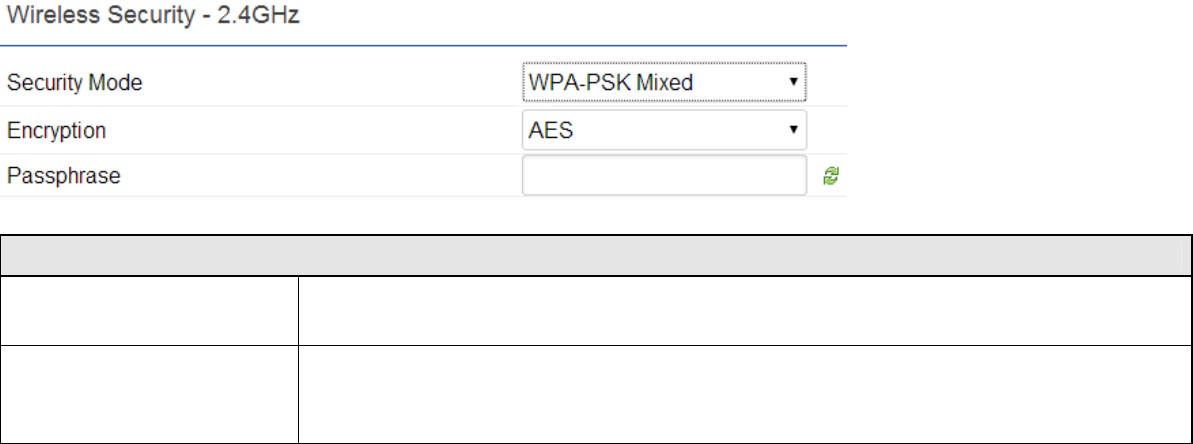
42
WPA-PSK Mixed Encryption: Only in Access Point / WDS AP mode
WPA
-
PSK Mixed
Encryption
Encryption
Select the WPA encryption
type
you would like.
Please ensure that your wireless clients use the same settings.
P
assphrase
Wireless clients must use the same key to associate the device.
If using ASCII format, the Key must be from 8 to 63 characters in length. If using HEX format,
the Key must be 64 HEX characters in length.
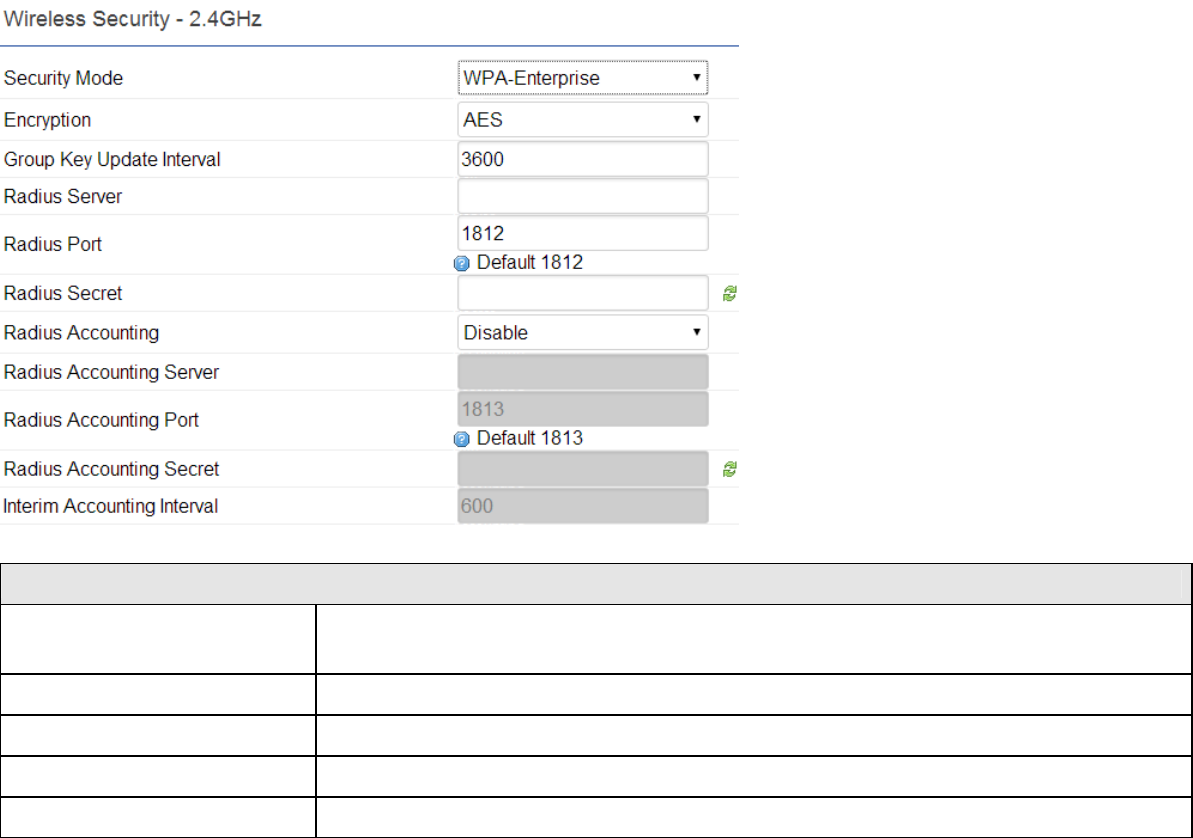
43
WPA Enterprise Encryption: Only in Access Point / WDS AP mode
WPA
Enterprise
Encryption
Encryption
Select the WPA encryption
type
you would like.
Please ensure that your wireless clients use the same settings.
Group Key Update Interval
Specify how often, in seconds, the group key changed.
R
adius
Server
Enter the IP address of the R
adius
s
erver
.
R
adius
Port
Enter the port number used for connections to the R
adius
server.
R
adius
Secret
Enter
the
secret
required to connect to the R
adius
server.
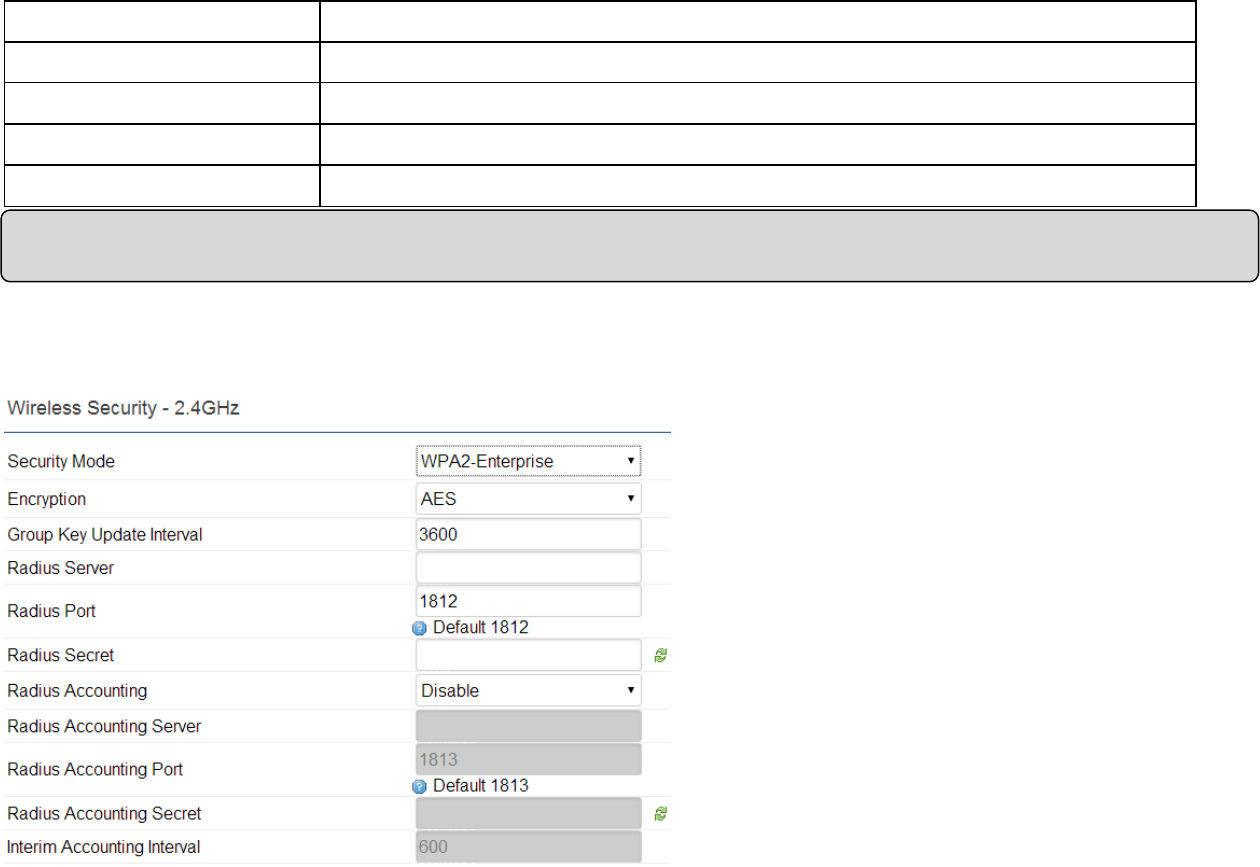
44
Radius Accounting
Enable or disable accounting feature.
Radius Accounting Server
Enter the IP address of the R
adius
a
ccounting
s
erver
.
Radius Accounting Port
Enter the port number used for connections
to the R
adius
accounting
server.
R
adius
Accounting Secret
Enter the
secret
required to connect to the R
adius
accounting
server.
Interim Accounting
I
nterval
Specify how often, i
n seconds,
the accounting data sends
.
WPA2 Enterprise Encryption: Only in Access Point / WDS AP mode
Note
:
802.11n does not allow WEP/WPA
-
PSK TKIP
/WPA2
-
PSK TKIP
security mode. The connection mode will automatically change from
802.11n to 802.11a/g.

45
WPA
2 Enterprise
Encryption
Encryption
Select the WPA encryption
type
you would like.
Please ensure that your wireless clients use the same settings.
Group Key Update Interval
Specify how often, in seconds, the group key
changed.
R
adius
Server
Enter the IP address of the R
adius
s
erver
.
R
adius
Port
Enter the port number used for connections to the R
adius
server.
R
adius
Secret
Enter the
secret
required to connect to the R
adius
server.
Radius Accounting
Enable or disable
accounting feature.
Radius Accounting Server
Enter the IP address of the R
adius
accounting s
erver
.
Radius Accounting Port
Enter the port number used for connections to the R
adius
accounting
server.
R
adius
Accounting Secret
Enter the
secret
required to c
onnect to the R
adius
accounting
server.
Interim Accounting I
nterval
Specify how often, i
n seconds,
the accounting data sends
.
Note
:
802.11n does not allow WEP/WPA
-
PSK TKIP
/WPA2
-
PSK TKIP
security mode. The connection mode w
ill automatically change from
802.11n to 802.11a/g.
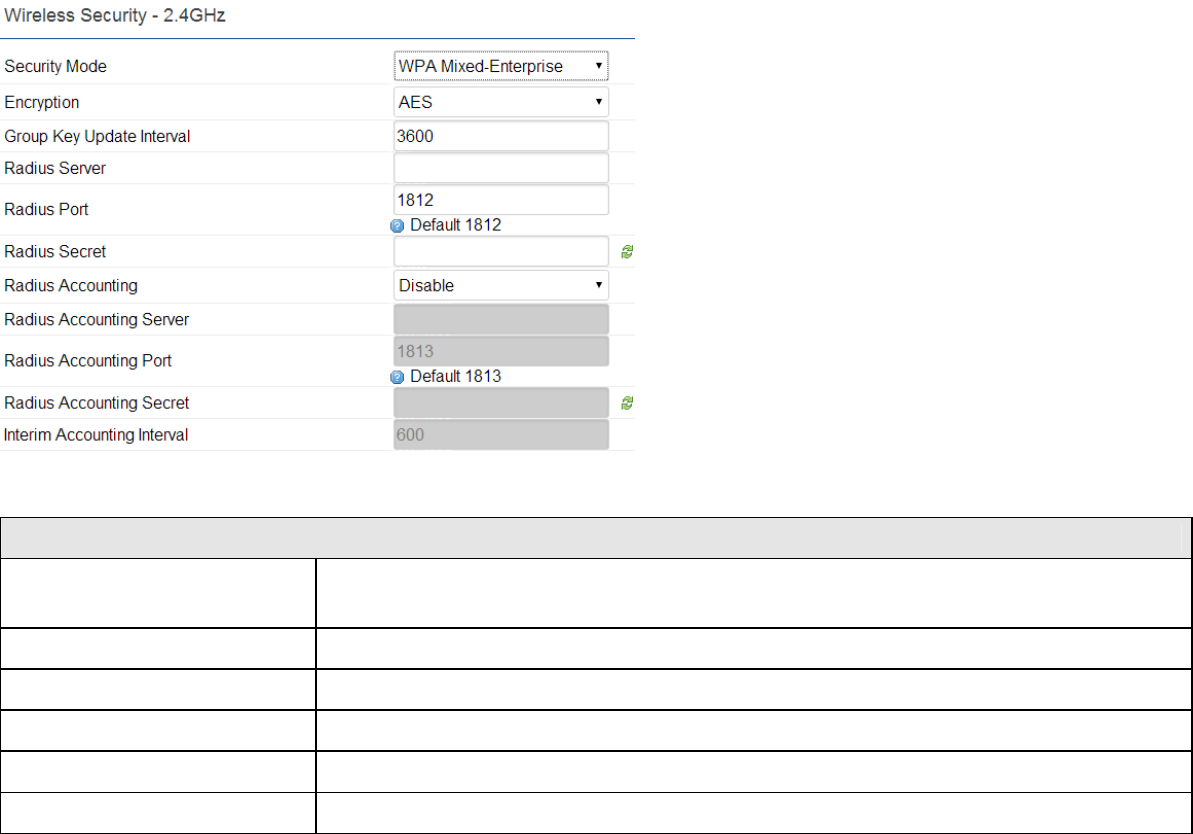
46
WPA Mixed Enterprise Encryption: Only in Access Point / WDS AP mode
WPA
Mixed Enterprise Encryption
Encrypti
on
Select the WPA encryption
type
you would like.
Please ensure that your wireless clients use the same settings.
Group Key Update Interval
Specify how often, in seconds, the group key changed.
R
adius
Server
Enter the IP address of the R
adius
s
erver
.
R
a
dius
Port
Enter the port number used for connections to the R
adius
server.
R
adius
Secret
Enter the
secret
required to connect to the R
adius
server.
Radius Accounting
Enable or disable accounting feature.

47
Radius Accounting Server
Enter the IP address of
the R
adius
accounting s
erver
.
Radius Accounting Port
Enter the port number used for connections to the R
adius
accounting
server.
R
adius
Accounting Secret
Enter the
secret
required to connect to the R
adius
accounting
server.
Interim Accounting I
nterval
S
pecify how often, i
n seconds,
the accounting data sends
.
Note
:
802.11n does not allow WEP/WPA
-
PSK TKIP
/WPA2
-
PSK TKIP
security mode. The connection mode will automatically change from
802.11n to 802.11a/g.

48
7.3 Fast Roaming
Enable the function to serve mobile client devices that roam from access point to access point. Some applications roam on
client devices require fast re-association when they roam to a different access point.
Please enter the settings of the SSID and initialize the Security mode to WPA2 enterprise, as well as to set the RADIUS
server firstly. User can enable Fast Roaming.
Please also set the same encryption under the same SSID on other access point and enable Fast Roaming. When the
configuration is activated on different access point, the mobile client devices can run the voice service and require
seamless roaming to prevent delay in conversation from access point to access point.
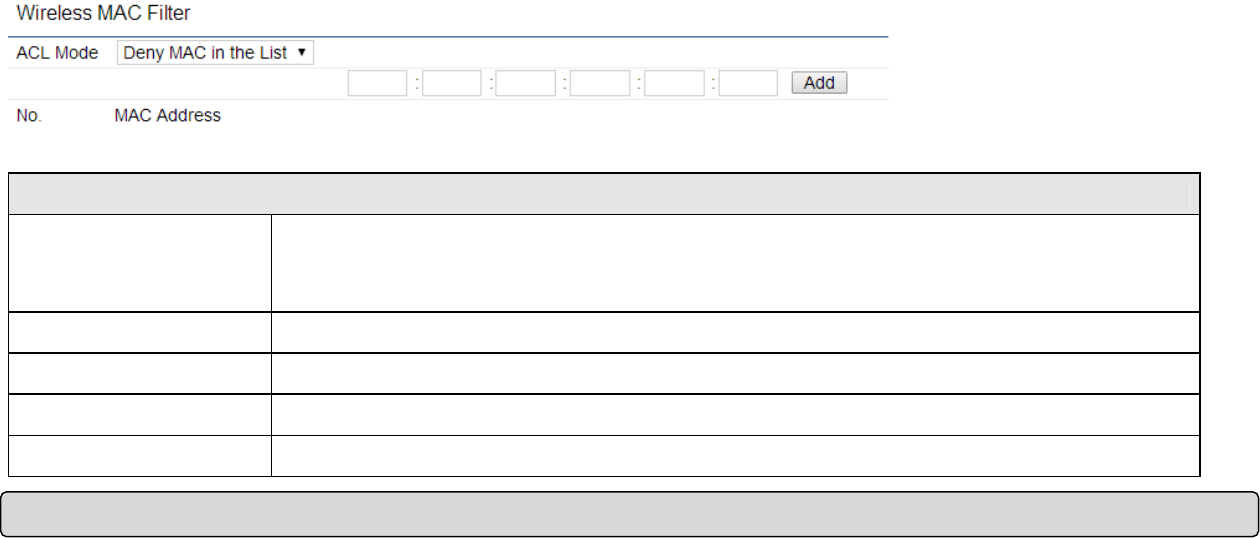
49
7.4 Wireless MAC Filtering
Wireless MAC Filtering is used to allow or deny network access to wireless clients (computers, tablet PCs, NAS,
smartphones, etc.) according to their MAC addresses. You can manually add a MAC address to restrict the permission to
access ECB1750. The default setting is Disable Wireless MAC Filter.
Wireless
MAC
Filter
(Access Point /
WDS AP
)
ACL Mode
Determines whether network access is granted or denied to clients whose MAC addresses
appear in the MAC Address table on this page. Choices are: Disabled, Deny MAC in the list, or
Allow MAC in the list.
MAC Address
Enter the MAC address of
the wireless client
.
Add
C
lick Add to add the MAC address to the MAC Address ta
ble.
Delete
Delete the selected entries.
Save
Cli
ck
Save to apply the changes.
Note:
Only
applicable
in Access Point, WDS AP mode.
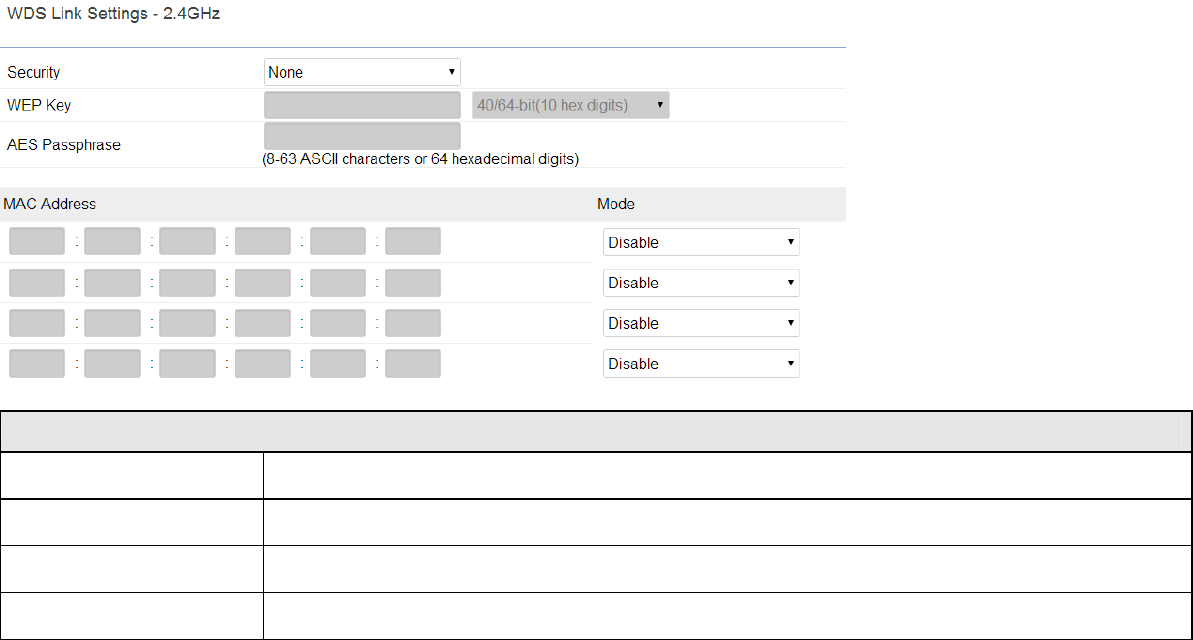
50
7.5 WDS Link Settings
WDS Bridge / WDS Station:
Using WDS (Wireless Distribution System) will allow a network administrator or installer to connect to Access Points
wirelessly. Doing so will extend the wired infrastructure to locations where cabling is not possible or inefficient to
implement.
2.4G/5G WDS Link Settings
Security
Select None or WEP or AES from drop
-
down list.
WEP Key
Enter the key values you wish to use
if
selecting WEP
.
AES Passphrase
Enter the key val
ues you wish to use
if selecting AES
.
MAC Address
Enter the Access Point’s MAC address to which you want to extend the wireless area.

51
Mode
Select Disable or Enable from the drop
-
down list.
Save
Click
Save to confirm the changes.
Note: Compatibility between different brands and models of access points is not guaranteed. It is recommended that the WDS network be
created using the same models for maximum compatibility.
Note: All Access Points in the WDS network needs to use the same Channel and Security settings.
To create a WDS network, please enter the MAC addresses of the Access Points that you want included in the WDS. There can be a maximum
of four access points.
Note: Only applicable in WDS AP and WDS Bridge mode.
Note: Other AP(s) must use the same security and key to establish WDS link.
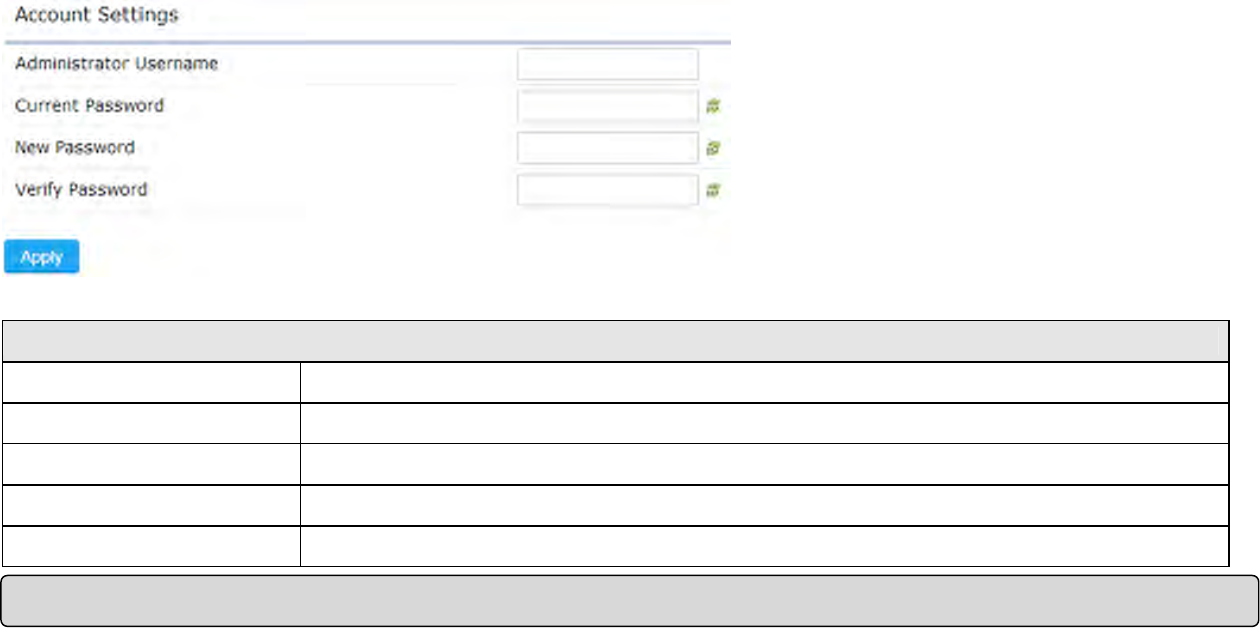
52
8 Management
8.1 Administration
This page allows you to change the ECB1750 username and password. By default, the username is admin and the
password is: admin. The password can contain 0 to 12 alphanumeric characters and is case sensitive.
Login Setting
New Name
Enter a new username for lo
gging in to the New Name entry box
.
Old Password
Enter
the old
password for lo
gging in to the
Old
Password entry box
.
New
Password
Enter
the
new password for lo
gging in to the
New
Password entr
y box
.
Confirm
Password
Re
-
enter the new
password in the Confirm Password entry box
for confirmation.
Apply
Click
Apply
to apply the changes
.
Note: It’s highly recommend that you change password to something unique for greater security.
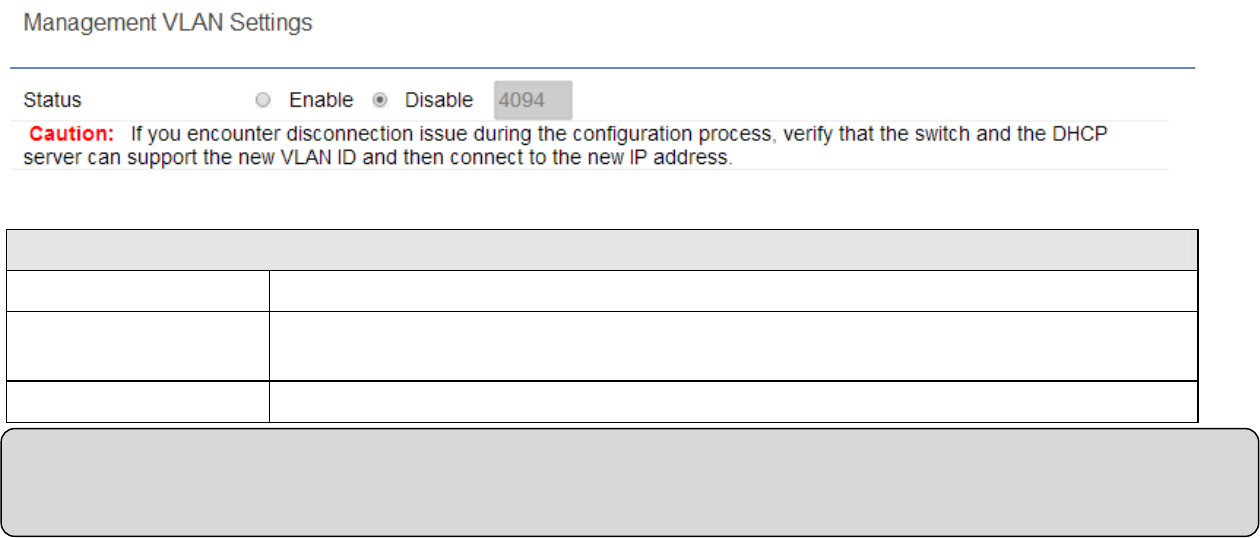
53
8.2 Management VLAN Settings
This page allows you to assign a VLAN tag to the packets. A VLAN is a group of computers on a network whose software
has been configured so that they behave as if they were on a separate Local Area Network (LAN). Computers on VLAN do
not have to be physically located next to one another on the LAN.
Management VLAN (
Access Point
/ WD
S
mode)
VLAN ID
Spec
ify the VLAN tag for
each
profile.
Management VLAN ID
If your network includes VLANs, you can specify a VLAN ID for packets pass through the Access
Point with a tag. Otherwise, select No VLAN tag.
Save
Click
Save
to confirm the chan
ges
.
Note: Only applicable in Access Point and WDS AP mode.
Note: If you reconfigure the Management VLAN ID, you may lose your connection to the ECB1750. Verify that the DHCP server supports the
reconfigured VLAN ID and then reconnect to the ECB1750 using the new IP address.
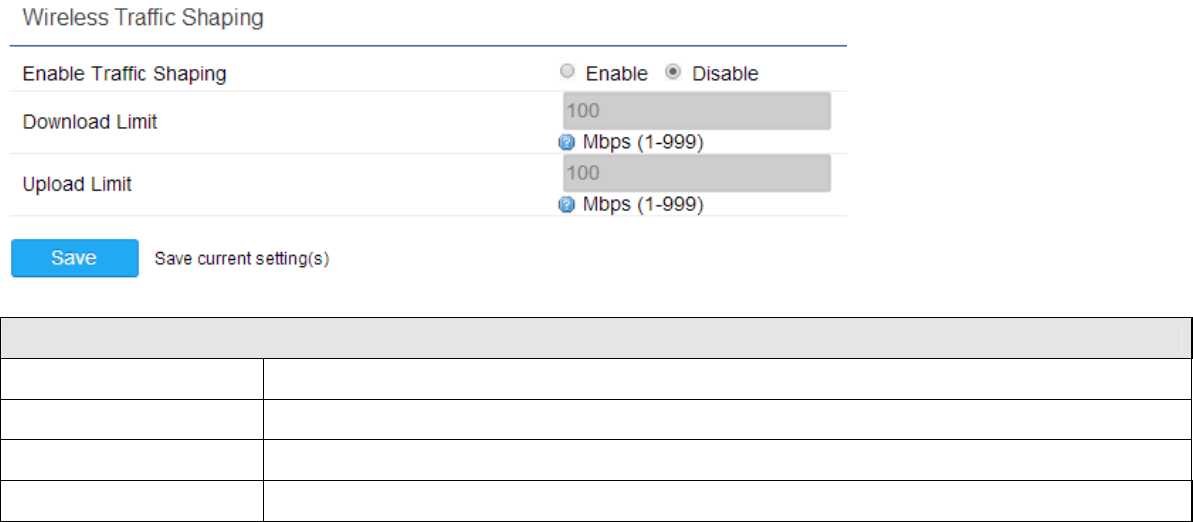
54
8.3 Wireless Traffic Shaping
Traffic shaping regulates the flow of packets leaving an interface to deliver improved Quality of Service. To edit Wireless
Traffic Shaping, click Edit for the SSID you would like to configure under Wireless Setting.
Wireless Traffic Shaping
Enable
Traffic Shaping
Check this option to enable wireless traffic shaping.
Download Limit
Specify
the wireless transmission speed used for downloading.
Upload Limit
Specify the wireless transmission speed used for uploadin
g.
Save
Click
Save to
confirm the changes
.
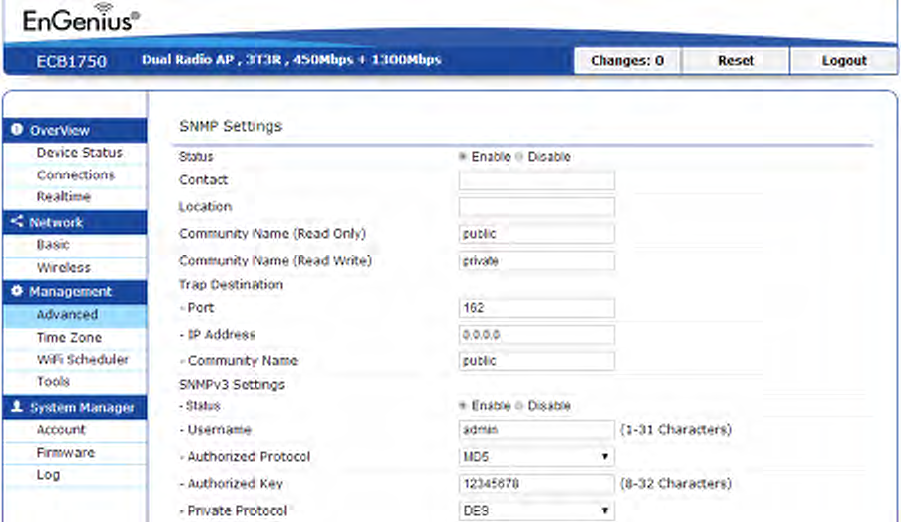
55
8.4 SNMP Settings
This page allows you to assign the Contact Details, Location, Community Name, and Trap Settings for Simple Network
Management Protocol (SNMP). This is a networking management protocol used to monitor network attached devices.
SNMP allows messages (called protocol data units) to be sent to various parts of the network. Upon receiving these
messages, SNMP compatible devices (called agents) return the data stored in their Management Information Bases. To
configure SNMP setting, click Advanced under sidebar Management section.

56
SNMP
Status
Enable or
D
isable SNMP feature.
Contact
Specify the contact details of the device
Location
Specify the location of the device.
Community
Name (
Read Only)
Specify the password for
the SNMP community for read only access.
Community Name
(Read/Write)
Specify the password for
the SNMP community with read/write access.
Trap
Trap Destination
Address
Specify the IP address of the computer that will r
eceive the SNMP traps.
Trap Destination Community
Name
Specify the password for the SNMP trap community.
SNMPv3
SNMPv3 Enable/Disable
Enable or
D
isable SNMPv3 feature.
User Name
Specify the username for
SNMPv3.
Auth Protocol
Select the
authentication
protocol
type
: MDS or SHA.
Auth Key
Specify the
authentication key
for
authentication
.
Priv Protocol
Select the privacy
protocol
type: DES.
Priv Key
Specify the
privacy key
for
privacy
.
Engine ID
Specify the engine ID for SNMPv3.
Apply
Click Apply to
apply the changes
.
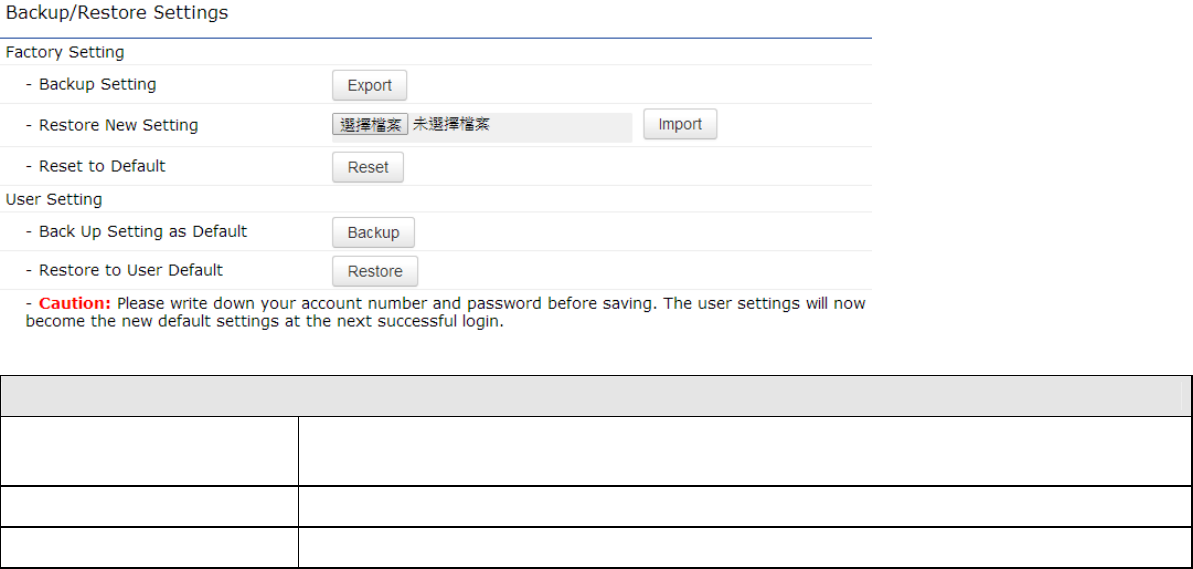
57
8.5 Backup/Restore
This page allows you to save the current device configurations. When you save the configurations, you also can reload the
saved configurations into the device through the Restore Saved Settings from A File section. If extreme problems occur, or
if you have set up the ECB1750 incorrectly, you can use the Factory Default button in the Revert to Factory Default Settings
section to restore all the configurations of the ECB1750 to the original default settings. To configure the Backup/Restore
Setting, click Firmware under the System Manager section in left side bar.
Factory Setting
Backup
Setting
To restore settings that have been previously backed up, click Export, select the file and
click
Restore.
Restore
New Setting
C
h
oose the file you wish restore for settings and click Import.
Reset to Default
Click
to Reset
button to resto
re the
ECB1750
to its factory default settings.

58
User Settings
Backup
Setting
Click Backup to backup the
user settings you would like to the device
’
s memory for the
user(WISP)’s default settings.
Restore
to User Default
Click Restore to restore user settings to the
user(WISP)
’
s default
settings.
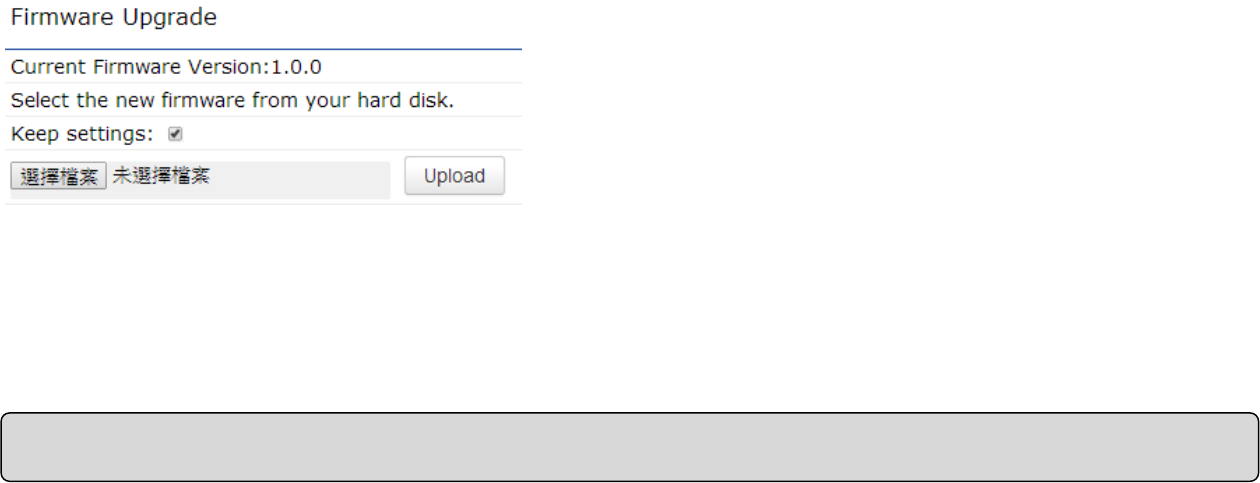
59
8.6 Firmware Upgrade
This page allows you to upgrade the firmware of the ECB1750.
To perform the Firmware Upgrade:
1. Click the Browse button and navigate the OS File System to the location of the upgrade file.
2. Select the upgrade file. The name of the file will appear in the Upgrade File field.
3. Click the Upload button to commence the firmware upgrade.
Note:
The
device
is unavailable during the upgrade process and must resta
rt when the upgrade is completed. Any connections to or through
the
device
will be lost.
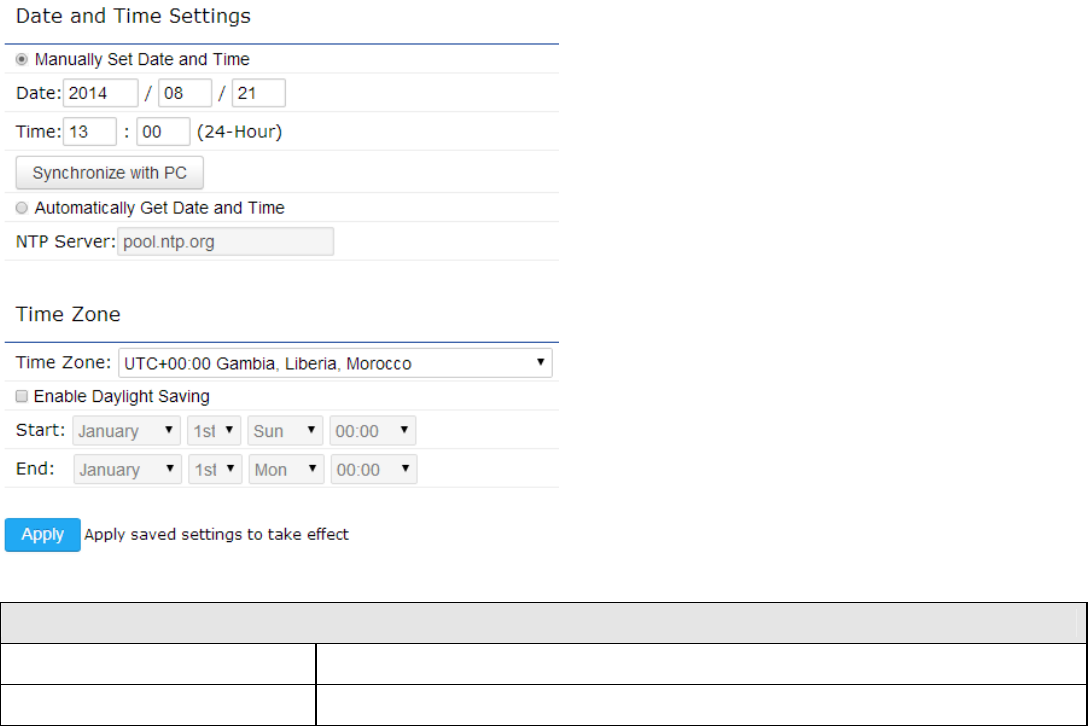
60
8.7 Time Settings
This page allows you to set the internal clock of the ECB1750. To access the Date and Time settings, click Time Zone under
the Management tab in left side bar.
Time
Manual
ly Set Date and Time
Manually specify the date and time
.
Synchronize with PC
C
l
ick to
Synchronize the ECB1750 with the computer
’
s internal clock.

61
Automatically Get Date and
Time
Select a time zone from the drop
-
down list and check whether you want to
enter the IP address of an NTP server or use the default NTP server to get have
the internal clock set automatically.
Time Zone
Choose the Time Zone you would like to use from the drop
-
down list.
Enable Daylight Saving
Check
the box to enable or disable day
light saving time for the ECB1750. Next,
enter the dates that correspond to the present year’s daylight savings time.
Apply
Click
Apply to apply the changes
.
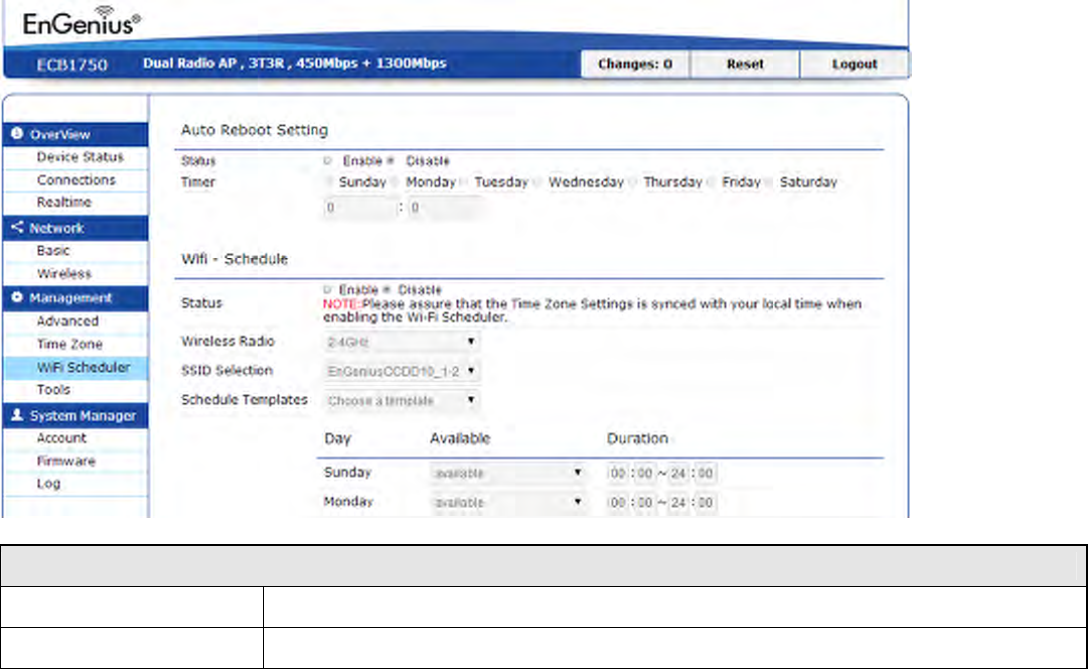
62
8.8 WiFi Scheduler
Use the schedule function to control the wireless on/off or reboot ECB1750 on a routine basis. The Schedule function relies
on the GMT time setting acquired from a network time protocol (NTP) server. For details on how to connect the ECB1750
to an NTP server, see Time Settings.
Auto Reboot Setting
Wifi Schedule
Select to
Enable
or
Disable
schedule function.
Timer
Specify the time in regularly rebooting ECB1750 by weekly time.

63
WiFi
Schedule
Status
Select to
Enable
or
Disable
schedule function.
Wireless Radio
Select to
2.4GHz or 5GHz frequency.
SSID Selection
Select
SSID which
has been set in Wireless Settings.
Schedule
Temp
late
s
Select the ECB1750 wireless service
schedule
A
l
ways Available or 8
-
5 daily or 8
-
5
daily except weekend or you can custom the desired schedule.
Save
Click Save to save changes, and it will be applied
after apply it in Changes on UI top
right tab.
Accept
Cli
ck A
ccept
to s
ave the settings
directly.

64
8.9 CLI Setting
Most users will configure the ECB1750 through the graphical user interface (GUI). However, for those who prefer an
alternative method there is the command line interface (CLI). The CLI can be access through a command console, modem
or Telnet connection.
CLI
Setting
CLI
Select
enable or disable
the ability to modify the
ECB1750
via a command line
interface (CLI).
Apply
Cl
ick Apply to app
ly th
e changes
.
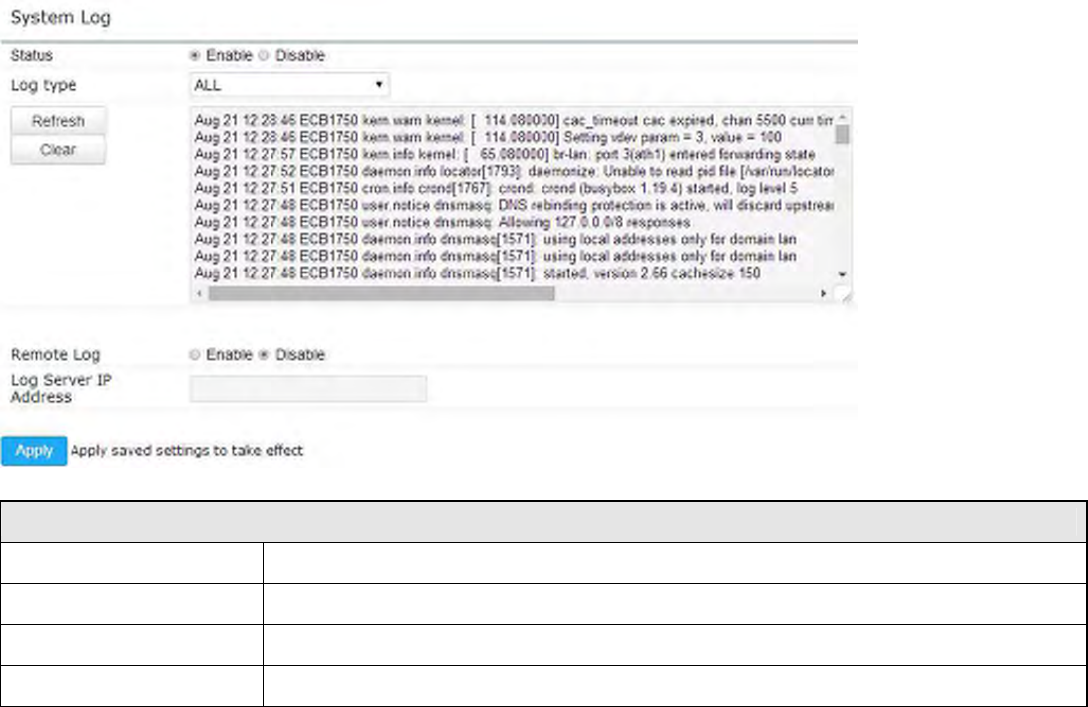
65
8.10 Systom Log
This page allows you to set up the System log and local log functions of the ECB1750. Click Log under the System
Manager tab to open the System log page.
Log
Syslog
Enable or disable the
syslog function.
Log Type
Select
the Log type mode you would like to use.
Remote Log
E
n
able or disable the Remote Log feature. If Enabled, enter the IP address of the Log.
Apply
Click
Apply to
apply the changes
.
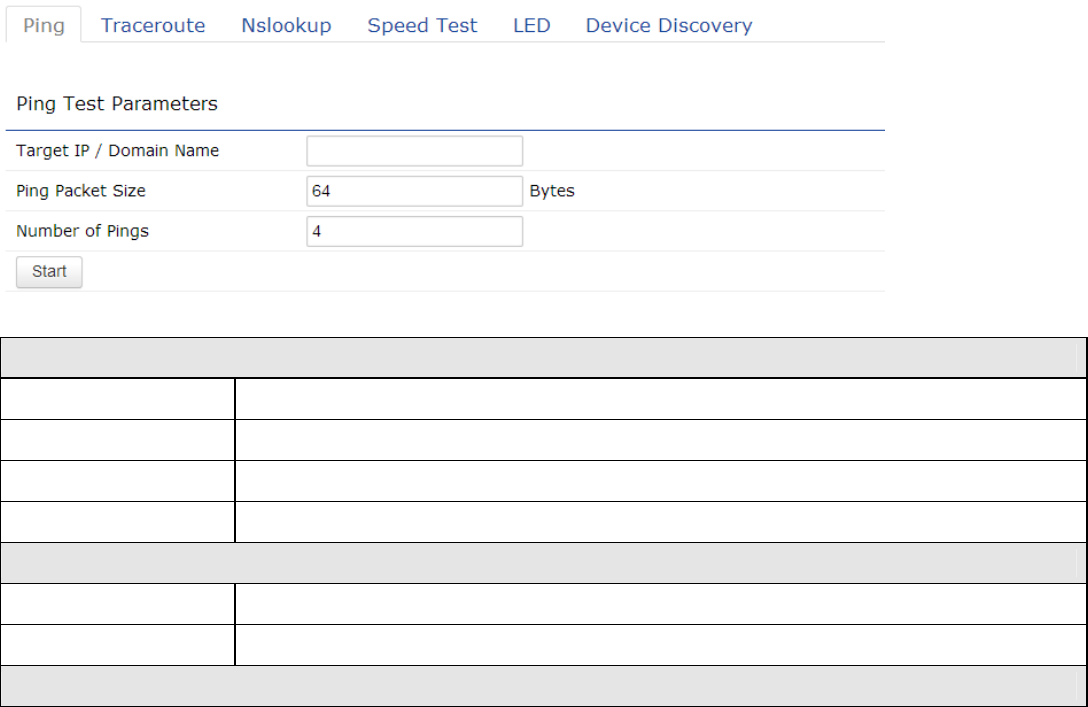
66
8.11 Tools
This page allows you to analyze the connection quality of the ECB1750 and trace the routing table to a target in the
network. Click Tools under Management section in left bar.
Tools
Target IP
Enter the IP address you would like to search.
Ping Packet Size
Enter the packet size of each ping.
Num
ber of Pings
Enter the number of times you want to ping.
Start Ping
Clic
k Start Ping to
begin pinging
target device (via IP)
.
Traceroute
Traceroute Target
Enter an IP address or domain name you want to trace.
Start
Click
Start Traceroute to
begin the
trace route operation.
Nslookup

67
Target
IP
Enter the IP address of the target PC.
Start
Click
Start to
begin the
DNS look up
operation.
Nslookup
Target IP
Enter the IP address of the target PC.
Time period
Enter time period for the speed test.
Check
Interval
Enter the interval
for the speed test.
Start Speed Test
Click Start Speed Test
to beg
in the speed test operation.
IPv4 / IPv6 Port
ECB1750
use IPv4 port 5001 and IPv6 port 5002 for the speed test.
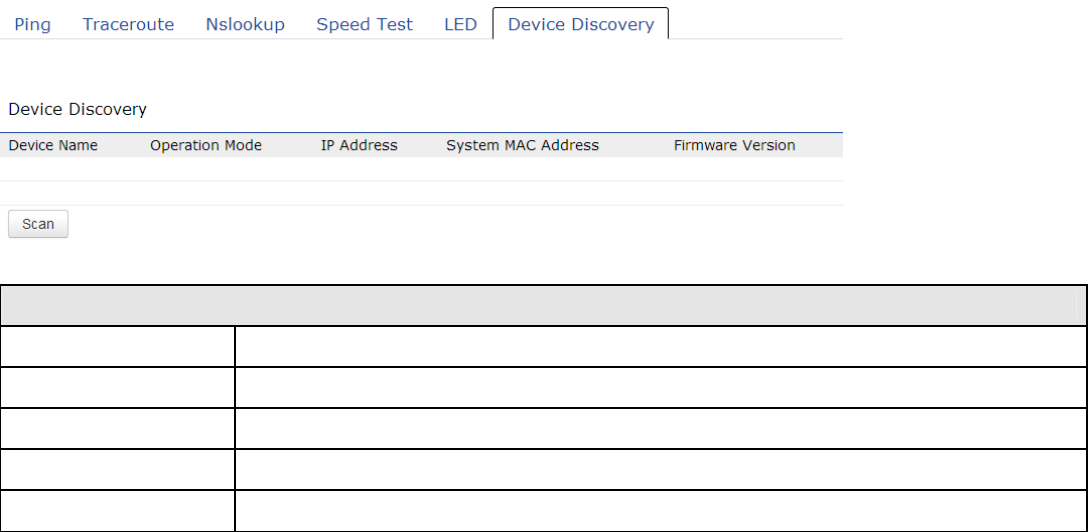
68
8.12 Device Discovery
This page shows the EnGenius device(s) connected with ECB1750 same network. Click Tools under Management section in
left bar.
Device Discovery
Device Name
Displays the name of the devices connected to the network.
Operation Mode
Displays the operation mode of the devices connec
ted to the network
.
IP Address
Displays the IP address of the devices connected to the network
.
System MAC Address
Displays the system MAC address of the devices connected to the network
.
Firmware Version
Displays the firmware version of the devices con
nected to the network.
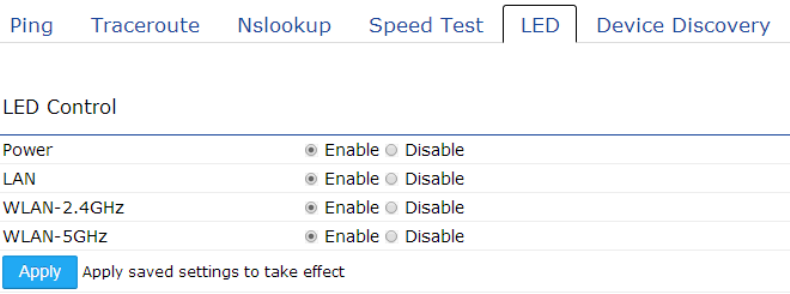
69
8.13 LED Control
This page allows you to control LED on/off for Power, LAN interface and 2.4G/5G WLAN interface. Click Tools under
Management section in left bar.
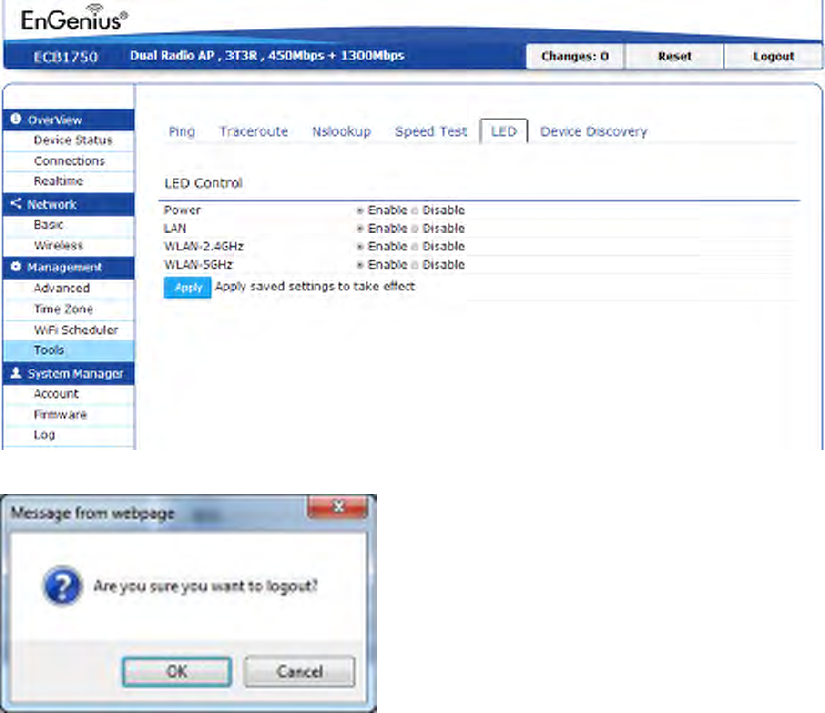
70
8.14 Logout
Click Logout on the top right bar.
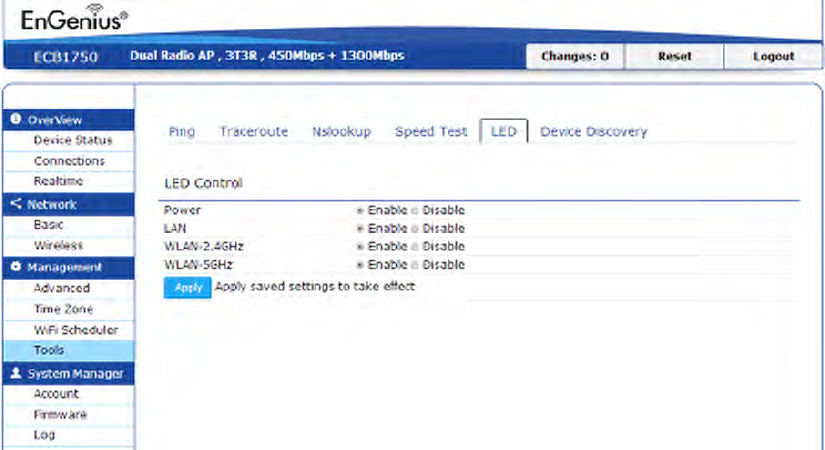
71
8.15 Reset
In some circumstances, it may be required to force the device to reboot. Click on Reboot the Device on the top right bar to
reboot the ECB1750.

72
Appendix A – FCC Interference Statement
Federal Communication Commission Interference Statement
This equipment has been tested and found to comply with the limits for a Class B digital device, pursuant to Part 15 of the FCC Rules.
These limits are designed to provide reasonable protection against harmful interference in a residential installation. This equipment
generates, uses and can radiate radio frequency energy and, if not installed and used in accordance with the instructions, may cause
harmful interference to radio communications. However, there is no guarantee that interference will not occur in a particular
installation. If this equipment does cause harmful interference to radio or television reception, which can be determined by turning
the equipment off and on, the user is encouraged to try to correct the interference by one of the following measures:
- Reorient or relocate the receiving antenna.
- Increase the separation between the equipment and receiver.
- Connect the equipment into an outlet on a circuit different from that
to which the receiver is connected.
- Consult the dealer or an experienced radio/TV technician for help.
FCC Caution: Any changes or modifications not expressly approved by the party responsible for compliance could void the user's
authority to operate this equipment.
This device complies with Part 15 of the FCC Rules. Operation is subject to the following two conditions: (1) This device may not cause
harmful interference, and (2) this device must accept any interference received, including interference that may cause undesired
operation.
This transmitter must not be co-located or operating in conjunction with any other antenna or transmitter.
Operations in the 5.15-5.25GHz band are restricted to indoor usage only.
IMPORTANT NOTE:
FCC Radiation Exposure Statement:
This equipment complies with FCC radiation exposure limits set forth for an uncontrolled environment. This equipment should be
installed and operated with minimum distance 33cm between the radiator & your body.

73
Appendix B – CE Interference Statement
1.1. Europe – EU Declaration of Conformity
This device complies with the essential requirements of the R&TTE Directive 1999/5/EC. The following test methods have been
applied in order to prove presumption of conformity with the essential requirements of the R&TTE Directive 1999/5/EC:
- EN60950-1
- Safety of Information Technology Equipment
- EN50385
- Generic standard to demonstrate the compliance of electronic and electrical apparatus with the basic restrictions related to human
exposure to electromagnetic fields (0 Hz - 300 GHz)
- EN 300 328
- Electromagnetic compatibility and Radio spectrum Matters (ERM); Wideband Transmission systems; Data transmission equipment
operating in the 2,4 GHz ISM band and using spread spectrum modulation techniques; Harmonized EN covering essential
requirements under article 3.2 of the R&TTE Directive
EN 301 893
Broadband Radio Access Networks (BRAN); 5 GHz high performance RLAN; Harmonized EN covering essential requirements of
article 3.2 of the R&TTE Directive
EN 301 489-1
Electromagnetic compatibility and Radio Spectrum Matters (ERM); ElectroMagnetic Compatibility (EMC) standard for radio
equipment and services; Part 1: Common technical requirements
- EN 301 489-17
- Electromagnetic compatibility and Radio spectrum Matters (ERM); ElectroMagnetic Compatibility (EMC) standard for radio
equipment and services; Part 17: Specific conditions for 2,4 GHz wideband transmission systems and 5 GHz high performance
RLAN equipment
-

74
This device is a 5GHz wideband transmission system (transceiver), intended for use in all EU member states and EFTA countries,
except in France and Italy where restrictive use applies.
In Italy the end-user should apply for a license at the national spectrum authorities in order to obtain authorization to use the device
for setting up outdoor radio links and/or for supplying public access to telecommunications and/or network services.
This device may not be used for setting up outdoor radio links in France and in some areas the RF output power may be limited to 10
mW EIRP in the frequency range of 2454 – 2483.5 MHz. For detailed information the end-user should contact the national spectrum
authority in France.
0560
Česky
[Czech]
[
Jméno výrobce]
tímto prohlašuje, že tento
[typ zařízení]
je ve shodě se základními požadavky a
dalšími příslušnými ustanoveními směrnice 1999/5/ES.
Dansk
[Danish]
Undertegnede [fabrikantens navn] erklærer herved, at følgende udstyr [udstyrets typebetegnelse]
overholder de væsentlige krav og øvrige relevante krav i direktiv 1999/5/EF.
Deutsch
[German]
Hiermit erklärt [Name des Herstellers], dass sich das Gerät [Gerätetyp] in Übereinstimmung mit den
grundlegenden Anforderungen und den übrigen einschlägigen Bestimmungen der Richtlinie
1999/5/EG befindet.
Eesti
[Estonian]
Käesolevaga kinnitab [tootja nimi = name of manufacturer] seadme [seadme tüüp = type of
equipment] vastavust direktiivi 1999/5/EÜ põhinõuetele ja nimetatud direktiivist tulenevatele teistele
asjakohastele sätetele.
English Hereby, [name of manufacturer], declares that this [type of equipment] is in compliance with the
essential requirements and other relevant provisions of Directive 1999/5/EC.
Español
[Spanish]
Por medio de la presente
[nombre del fabricante]
declara que el
[clase de equipo]
cumple co
n los
requisitos esenciales y cualesquiera otras disposiciones aplicables o exigibles de la Directiva
1999/5/CE.
Ελληνική
[Greek]
ΜΕ ΤΗΝ ΠΑΡΟΥΣΑ [name of manufacturer] ∆ΗΛΩΝΕΙ ΟΤΙ [type of equipment] ΣΥΜΜΟΡΦΩΝΕΤΑΙ
ΠΡΟΣ ΤΙΣ ΟΥΣΙΩ∆ΕΙΣ ΑΠΑΙΤΗΣΕΙΣ ΚΑΙ ΤΙΣ ΛΟΙΠΕΣ ΣΧΕΤΙΚΕΣ ∆ΙΑΤΑΞΕΙΣ ΤΗΣ Ο∆ΗΓΙΑΣ 1999/5/ΕΚ.
Français
[French]
Par la présente [nom du fabricant] déclare que l'appareil [type d'appareil] est conforme aux exigences
essentielles et aux autres dispositions pertinentes de la directive 1999/5/CE.
Italiano
[Italian]
Con la presente [nome del costruttore] dichiara che questo [tipo di apparecchio] è conforme ai requisiti
essenziali ed alle altre disposizioni pertinenti stabilite dalla direttiva 1999/5/CE.

75
Latviski
[Latvian]
Ar šo [name of manufacturer / izgatavotāja nosaukums] deklarē, ka [type of equipment / iekārtas tips]
atbilst Direktīvas 1999/5/EK būtiskajām prasībām un citiem ar to saistītajiem noteikumiem.
Lietuvių
[Lithuanian]
Šiuo [manufacturer name] deklaruoja, kad šis [equipment type] atitinka esminius reikalavimus ir kitas
1999/5/EB Direktyvos nuostatas.
Nederlands
[Dutch]
Hierbij verklaart [naam van de fabrikant] dat het toestel [type van toestel] in overeenstemming is met
de essentiële eisen en de andere relevante bepalingen van richtlijn 1999/5/EG.
Malti
[Maltese]
Hawnhekk,
[
i
sem tal
-
m
anifattur]
, jiddikjara li dan
[il
-
mudel
tal
-
prodott]
jikkonforma mal
-
ħtiġijiet
essenzjali u ma provvedimenti oħrajn relevanti li hemm fid-Dirrettiva 1999/5/EC.
Magyar
[Hungarian]
Alulírott, [gyártó neve] nyilatkozom, hogy a [... típus] megfelel a vonatkozó alapvetõ
követelményeknek és az 1999/5/EC irányelv egyéb elõírásainak.
Polski
[Polish]
Niniejszym [nazwa producenta] oświadcza, że [nazwa wyrobu] jest zgodny z zasadniczymi wymogami
oraz pozostałymi stosownymi postanowieniami Dyrektywy 1999/5/EC.
Português
[Portuguese]
[Nome do fa
bricante]
declara que este
[tipo de equipamento]
está conforme com os requisitos
essenciais e outras disposições da Directiva 1999/5/CE.
Slovensko
[Slovenian]
[Ime proizvajalca] izjavlja, da je ta [tip opreme] v skladu z bistvenimi zahtevami in ostalimi relevantnimi
določili direktive 1999/5/ES.
Slovensky
[Slovak]
[Meno výrobcu] týmto vyhlasuje, že [typ zariadenia] spĺňa základné požiadavky a všetky príslušné
ustanovenia Smernice 1999/5/ES.
Suomi
[Finnish]
[Valmistaja = manufacturer] vakuuttaa täten että [type of equipment = laitteen tyyppimerkintä]
tyyppinen laite on direktiivin 1999/5/EY oleellisten vaatimusten ja sitä koskevien direktiivin muiden
ehtojen mukainen.
Svenska
[Swedish]
Härmed int
ygar
[företag]
att denna
[utrustningstyp]
står I överensstämmelse med de väsentliga
egenskapskrav och övriga relevanta bestämmelser som framgår av direktiv 1999/5/EG.